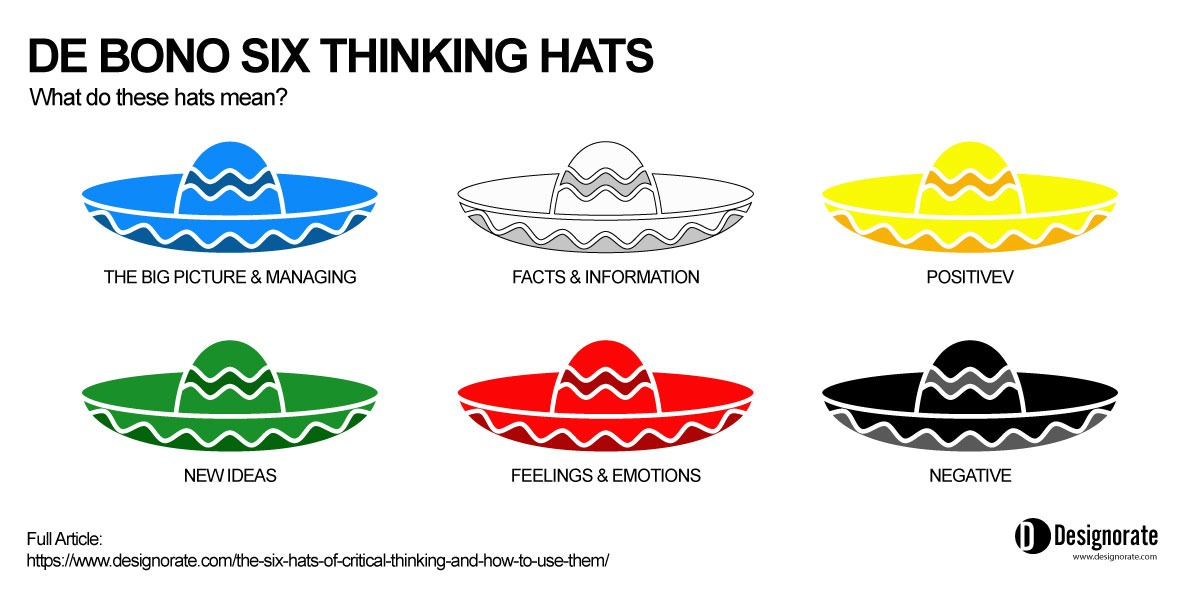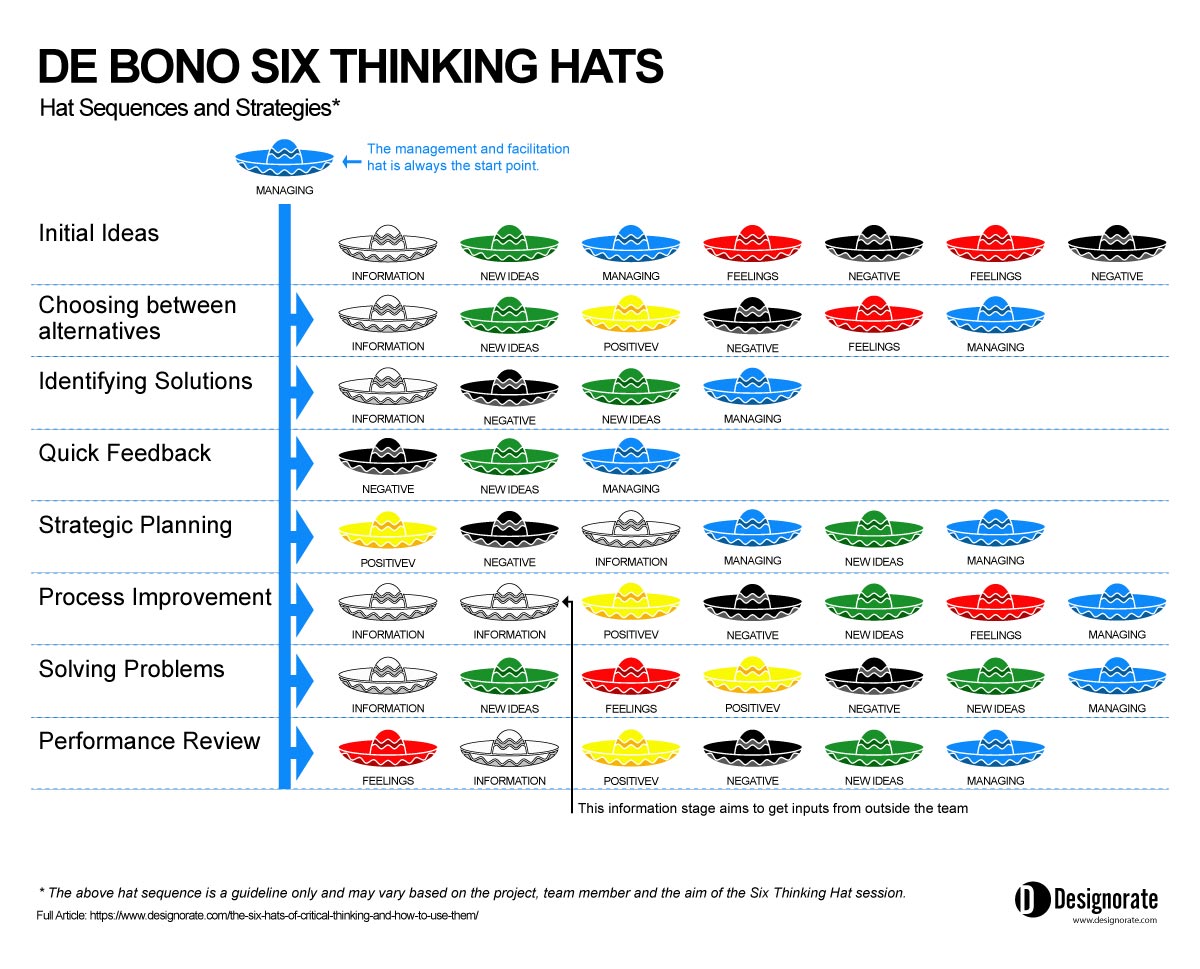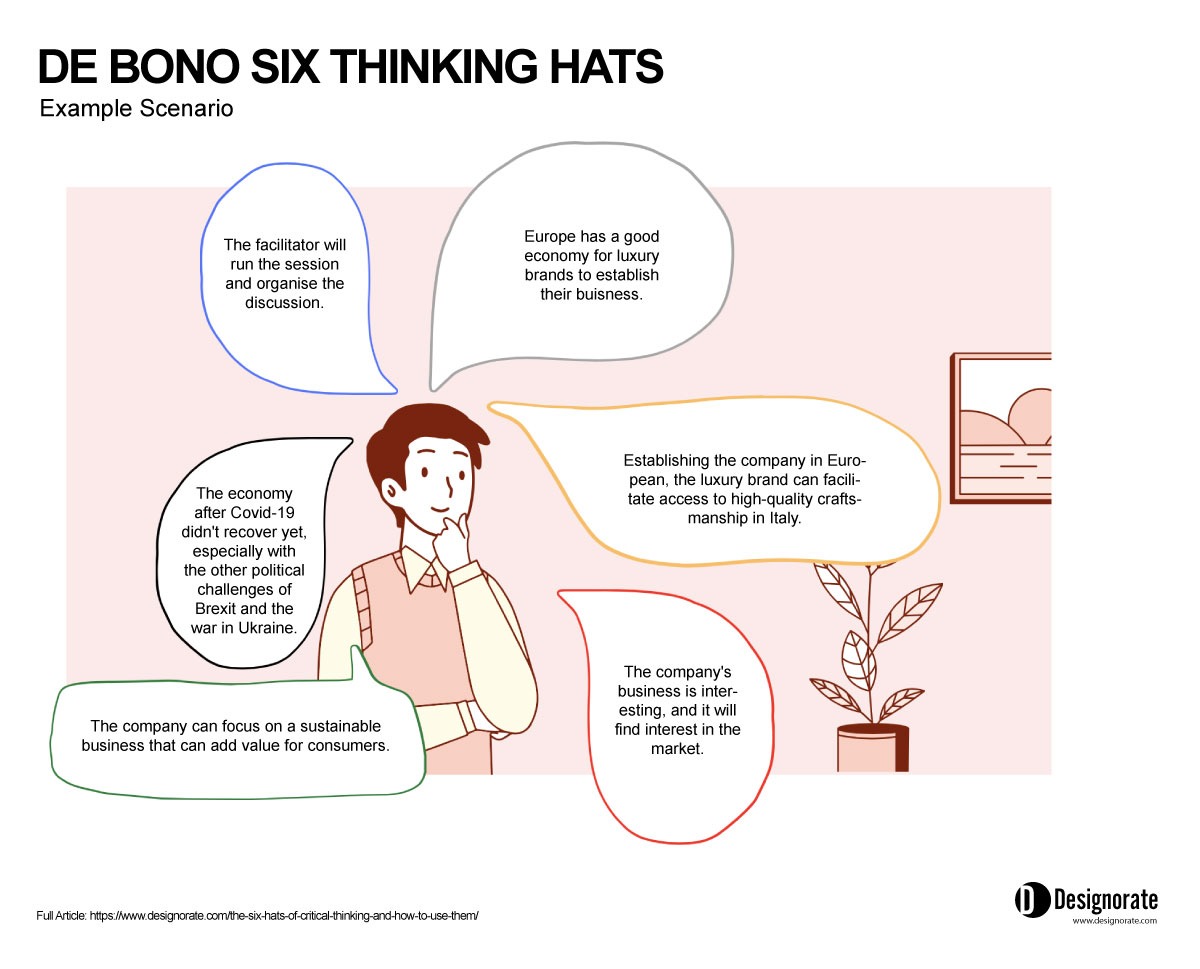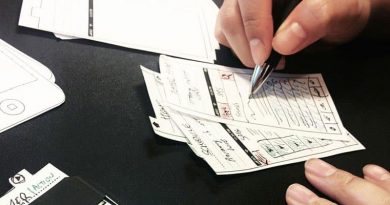
- Skip to main content
- Skip to primary sidebar
- Skip to footer

Additional menu

The six thinking hats method: how to use it for effective brainstorming
August 10, 2023 by MindManager Blog
Learn how to effectively use the six thinking hats method to foster diverse perspectives and improve decision-making. Discover practical tips and techniques to promote more productive and collaborative thinking in your team!
What is Edward De Bono’s six thinking hats brainstorming method?
Edward De Bono’s six thinking hats is a decision-making and problem-solving method that encourages parallel thinking and creativity.
Parallel thinking is a term coined by De Bono. It’s a collaborative thought process where people explore different perspectives on a topic, enabling a balanced and productive brainstorming environment.
The six thinking hats process involves a facilitator guiding participants through different thinking styles by symbolically wearing different hats. Using these hats, participants explore a topic, one perspective at a time, giving everyone an equal chance to contribute without debate or criticism.
We’ll dive deeper into this later, but for now, here’s a quick breakdown of what each hat represents and its related thinking style:
- White hat: Objective data analysis.
- Red hat: Emotional and intuitive responses.
- Black hat: Critical judgment for identifying risks and flaws.
- Yellow hat: Positive thinking for exploring benefits.
- Green hat: Creative and innovative ideas.
- Blue hat: Facilitation and process control.
In all, the six thinking hats process provides a framework that improves collaboration, decision-making, and problem-solving by leveraging the power of parallel thinking and tapping into group intellect.
The 6 benefits of six thinking hats
There are many benefits of the six thinking hats brainstorming technique that may be of interest when problem-solving and decision-making. Some of these include:
1. Enhanced creativity
The six thinking hats method stimulates creative thinking by encouraging participants to explore various perspectives, generate new ideas, and think outside the box.
By wearing different hats, individuals are encouraged to step out of their comfort zones and explore uncommon ideas. Overall, the method promotes nontraditional thinking and unlocks fresh ideas and possibilities.
2. Balanced thinking
Each of the six hats ensures balanced thinking by considering all angles of a topic, including:
- Facts
- Emotion
- Critical judgments
- Positive thinking
- Creativity
- Process control
When all of these factors are considered, the results are more balanced and fairer. This allows participants to see the topic, idea, or problem comprehensively.
3. Improved collaboration
The structured framework of the six thinking hats facilitates effective collaboration by ensuring that all participants can contribute to the discussion. Furthermore, they have the opportunity to share their viewpoints without conflicts or interruptions.
4. Efficient decision-making
The method enables faster and more efficient decision-making by systematically analyzing different aspects, risks, benefits, and alternative possibilities.
By doing so, the method helps streamline the decision-making process, reducing the time spent on deliberation and enabling timely outcomes. Moreover, the approach minimizes the risk of overlooking important factors, which helps to create solid solutions.
5. Reduced bias and subjectivity
The six thinking hats technique asks participants to temporarily set aside their personal biases and judgments and focus on the specific thinking style that their appointed hat represents.
By encouraging a temporary shift in thinking, individuals can approach a problem or idea with an objective mindset. This enables them to consider perspectives based on logical reasoning rather than personal biases.
6. Increased productivity
The six hats process provides a structured and organized approach to brainstorming , ideation, and planning, which increases productivity.
During a session, discussions remain concentrated on the overall goal. By channeling efforts towards a common objective, participants can streamline their thought processes, eliminate distractions, and maintain focus throughout the session.
This increased clarity contributes to heightened productivity as team members use their collective intelligence to achieve outcomes quickly.
The six thinking hats step-by-step process
The six thinking hats process, developed by Edward De Bono, is a structured method for brainstorming, problem-solving , and decision-making.
The process involves the following steps, participants, facilitation, and tools:
- Define the focus. The session begins by clearly defining the problem, idea, or topic of discussion that requires brainstorming and decision-making.
- Select participants. Select a diverse group of individuals who bring different perspectives, expertise, and roles to the discussion.
- Introduce the six hats. The chosen facilitator introduces the concept of the six thinking hats and explains the meaning and role of each hat color. Participants are briefed on the thinking styles associated with each hat and the purpose they serve during the session.
- Assign hat roles. The facilitator assigns specific hat roles to participants. Each person is responsible for wearing a particular hat for a given period.
- Hat rotation. The session progresses with hat rotation, where participants switch roles by changing hats at designated intervals. This rotation ensures that every participant has the chance to contribute from different perspectives and prevents individuals from becoming fixated on a single thinking style.
- Hat exploration. While wearing a specific hat, participants share their thoughts, ideas, observations, or questions related to the topic. The facilitator guides the discussion, ensuring that the focus remains on the thinking style represented by the current hat.
- Facilitator’s role. The facilitator plays a crucial role in managing the session. They guide the flow of the discussion, enforce hat rotation, encourage active participation, and maintain a balanced and inclusive environment. The facilitator also ensures that all participants have an opportunity to express their views and that the session stays on track.
- Tools and visual aids. The brainstorming process can be supported by visual aids so that participants can jot down key points, ideas, or observations associated with their hat. Visual representations help in organizing thoughts and summarizing outcomes.
- Summarize and analyze. At the end of the session, the facilitator summarizes the key insights, observations, ideas, and conclusions from each thinking style. This summary helps to consolidate the collective understanding, identify patterns, and inform subsequent decision-making processes.
The six thinking hats colors and what they represent
Each hat in the six thinking hats method represents a distinct thinking style. The collective use of these hats during a brainstorming session facilitates the evaluation of ideas and well-rounded decision-making.
Red hat
The red hat represents emotions and intuition. When wearing the red hat, participants can express their feelings, gut instincts, and subjective opinions without the need for justification.
This hat encourages the open sharing of personal perspectives and taps into the intuitive and emotional aspects of decision-making. It helps to foster a more holistic understanding of the topic at hand.
Green hat
The green hat symbolizes creativity and new ideas. Participants wearing the green hat are encouraged to think innovatively, develop fresh ideas, and explore alternative possibilities.
This hat promotes divergent thinking, encourages brainstorming, and stimulates creative solutions. It adds a spark of inventiveness to the session.
Blue hat
The blue hat represents process control and organization. It plays the role of a facilitator in the brainstorming session.
The blue hat wearer manages the overall thinking process, guides the discussion, and ensures the session stays on track. They summarize outcomes, coordinate the contributions of different hats, and keep the session focused and productive.
Yellow hat
The yellow hat signifies positive thinking. Participants wearing the yellow hat focus on exploring the benefits, advantages, and positive aspects of the ideas or proposal.
Yellow hat wearers look for value, prospects, and optimistic perspectives. In addition, they help to create a constructive and forward-thinking atmosphere.
White hat
The white hat is associated with facts and information. It represents a logical and objective thinking style.
Participants wearing the white hat gather and analyze data, facts, and information relevant to the topic. They provide an objective foundation and add evidence-based insights, helping the group make well-informed decisions.
Black hat
The black hat embodies critical judgment. Participants wearing the black hat take a cautious and critical approach.
They identify potential risks, flaws, and negative aspects of ideas or proposals. The black hat thinking style aims to identify pitfalls, challenge assumptions, and encourage careful evaluation.
When to use the six thinking hats method
The six thinking hats method provides a framework for collaborative brainstorming that maximizes the potential of a team’s collective intelligence. As a result, sessions may be more creative and effective.
The six hats thinking method is particularly useful in situations where:
- A team needs to generate new ideas or solutions.
- There are diverse opinions or conflicts among team members.
- A comprehensive evaluation of ideas is required.
- Emotional or intuitive aspects need to be considered alongside logical reasoning.
- The decision-making process needs to be more objective and rational.
Six thinking hats example
To understand the six thinking hats method more fully, here’s an example of how the process may play out in a real-life scenario:
- Team : The marketing team at a tech company.
- Objective : Generate innovative marketing campaign ideas for a new product launch.
- Process : The team leader introduces the six thinking hats method and assigns specific hat roles to each team member.
- Red hat (emotions and intuition): The individual wearing the red hat openly expresses their gut feelings and emotional responses towards the marketing campaign ideas at hand. They discuss their personal inclinations and share their enthusiasm or concerns about specific campaign concepts.
- Green hat (creativity) : The green hat team member freely shares creative marketing campaign ideas without criticism. They generate diverse ideas, such as viral videos, interactive social media campaigns, and experiential events.
- White hat (facts and information): The team transitions to the person wearing the white hat. Here, the individual analyzes the feasibility and gathers data on the market campaign ideas. They consider budget constraints, target audience demographics, and competitor analysis.
- Black hat (critical judgment): Moving to the black hat, this individual critically evaluates the ideas on the table. They identify potential risks, such as legal implications, negative public perception, or budget overruns. They weigh the pros and cons of each idea and highlight any drawbacks or challenges.
- Yellow hat (positive thinking): The person wearing the yellow hat focuses on the positive aspects of the campaign ideas. They discuss potential benefits, advantages, and opportunities for each concept. They also highlight the possible impact on brand awareness, customer engagement, and market differentiation
- Blue hat (process control): This team member takes on the role of session manager. They summarize the key insights and guide the discussion toward the most promising ideas. They also highlight the most feasible concepts from the overall hat discussion.
- Results : The brainstorming session allowed the marketing team to explore various creative marketing campaign ideas. The team considered diverse perspectives, backed by data and discussion.
The session facilitated inclusive participation and balanced the exploration of ideas. As a result, the team identified three promising campaign concepts:
- A gamified social media contest.
- An influencer-driven product launch event.
- An interactive augmented reality experience.
The team left the session with a clear direction for further developing and refining these ideas. This led to a more informed and effective marketing strategy for the new product launch.
Unleash the power of the six thinking hats method for brainstorming and take your ideation sessions to new heights!
Explore the benefits of MindManager®, the ultimate mind mapping tool, to unlock innovative ideas, foster collaboration, and make informed decisions.
Sign up for a free trial today and supercharge your brainstorming sessions with MindManager!
Six thinking hats frequently asked questions (FAQ)
Below are a few commonly asked questions about the six thinking hats brainstorming method:
What is six thinking hats?
The six thinking hats is a method developed by Edward De Bono for structured thinking and decision-making. It involves wearing six metaphorical hats, each representing a specific thinking style.
This technique explores ideas, analyzes information, considers emotions, and facilitates well-rounded and effective discussions.
How do teams use six thinking hats?
Teams use the six thinking hats to develop unique perspectives and ideas. By assigning different hats to each participant, teams can work together to think outside the box and enjoy efficient and productive brainstorming, problem-solving, and decision-making.
What are the benefits of six thinking hats?
The benefits of six thinking hats include:
- Enhanced creativity
- Balanced perspectives
- Improved decision-making
- Efficient collaboration
- Effective problem-solving
- Increased productivity
Ready to take the next step?
MindManager helps boost collaboration and productivity among remote and hybrid teams to achieve better results, faster.
Why choose MindManager?
MindManager® helps individuals, teams, and enterprises bring greater clarity and structure to plans, projects, and processes. It provides visual productivity tools and mind mapping software to help take you and your organization to where you want to be.
Explore MindManager

Work Life is Atlassian’s flagship publication dedicated to unleashing the potential of every team through real-life advice, inspiring stories, and thoughtful perspectives from leaders around the world.

Contributing Writer
Work Futurist

Senior Quantitative Researcher, People Insights
Principal Writer
Our State of Teams 2024 report is live! Check it out here .

Six Thinking Hats: use parallel thinking to tackle tough decisions
Stuck in a stalemate? Try this time-honored technique on for size.

Get stories like this in your inbox
Think back to the last major decision your team made together. Was there a struggle to get everyone to offer input? Did one person dominate the discussion? Did everyone quickly rally around one idea without exploring alternatives?
The brilliance of a diverse team is that each individual has unique perspectives to contribute to the larger picture. But tapping into those insights can be a challenge when multiple people are involved in a discussion – especially when a team is tasked with making a difficult decision.
If you’re seeking a more balanced, systematic approach that makes room for everyone’s voice, try the Six Thinking Hats. Below, we’ll explore this decision-making tool that teams at IBM and NASA have used to break down biases and tackle tough choices.
Six Thinking Hats: what is it and where did it come from?
Physician, psychologist, and author Edward de Bono conceived of the Six Thinking Hats and describes how it works in his 1985 book of the same name. In this role-playing exercise, participants “put on” six different metaphorical hats that each represent a certain type of thinking.
According to de Bono, the Six Thinking Hats method serves two main purposes:
- It eliminates confusion by focusing the discussion on one aspect of the decision at a time, such as potential risks or possible benefits.
- It encourages more expansive thinking so a person does not get boxed into only looking at the risks, or conversely, only focusing on the benefits.
De Bono asserts that Western thinking is based on an argument system, where one person makes a statement and another challenges it. The Six Thinking Hats offers an alternative: parallel thinking.
“Parallel thinking means that at any moment everyone is looking in the same direction,” de Bono writes in Six Thinking Hats. While argument focuses on “what is,” parallel thinking looks at “what can be.”
By looking in the same direction at the same time, the entire team can collaborate on a solution and continuously move the discussion forward, instead of getting mired in debate, resulting in more balanced decision-making.
How it works
In his book, de Bono encourages the use of bits and pieces of his technique and its nomenclature in a variety of situations. You can use the hats in everyday workplace conversations as symbols to request a type of thinking. However, the Six Thinking Hats method as a formal, structured sequence (which we’ll describe below) is best suited for:
- Complicated or significant decisions
- Decision-making discussions involving multiple people
- Discussions in which you’re having a hard time getting everyone to participate (e.g., one person is doing most of the talking or a couple of people are hesitant to speak up).
- Brainstorming sessions where you need to cover all the bases and possibilities thoroughly
- Any situation where you want to explore options and ideas more holistically and be inclusive of everyone’s thoughts and feelings
Step 1: Define an issue to discuss. Six Thinking Hats sessions should be focused on a particular problem that needs to be solved or a decision that needs to be made.
Step 2: Assign the blue hat to one person. The blue hat is the meeting leader who starts and ends the discussion and announces when it’s time to change hats.
Step 3: As a group, go through each hat, one at a time. How much time should your team spend under each hat? De Bono recommends one minute per attendee. So if five people are present, dedicate five minutes total to each hat. If you need to go over, you can extend the time, but de Bono recommends keeping each “hat session” brief and focused.
Step 4: Define the outcome. By the end of the session, your team should be able to make a decision and decide on the next steps.
The six hats defined
Let’s use an example to illustrate how a team might use the Six Thinking Hats to have more productive discussions and make better decisions faster, based on de Bono’s method.
| Since going hybrid in 2021, usage of our office space is low, while rent continues to rise. Do we stick with the hybrid work model or ditch the commercial office space and return to being fully remote, or is there an even better option? |
With this problem statement in mind, let’s cycle through each of the six hats and show how they might be used to solve this issue.
🔵 Blue hat: moderator
When you think of the blue hat, think of the sky overhead: all-encompassing. Under the blue hat, you’ll be “thinking about thinking.”
More on the blue hat
One person wears the blue hat – in essence, acts as a moderator – for the entirety of the session, but all attendees are asked to participate in two “blue hat sessions”: one at the beginning of the discussion to frame the conversation and one at the end to define the outcome and next steps. All the other hats are “worn” by the whole group together.
Whoever puts on that blue hat is the neutral moderator who:
- Kicks off and ends the meeting
- Frames the intent of the discussion and sets the agenda
- Announces the change of hats
- Poses questions
- Enforces rules
- Asks for the outcome of the discussion
| BLUE THINKING HAT | |
|---|---|
| What should we be thinking about? Is this discussion productive so far? Is this the real problem, or is there something else we should explore? | “I think we’ve strayed from the defined scope of this discussion. Let’s refocus on our hybrid work model and possible alternatives.” “My blue hat thinking is that the real issue isn’t low office space usage or rising rents. The real issue is a lack of employee connection.” “Putting on my blue hat, I think we should pause and summarize the main points of the discussion so far.” |
⚪️ White hat: information
The white hat is concerned with “just the facts.” White-hat thinkers remain neutral, looking only at the available information without making interpretations about it. Under the white hat, you may put forth facts that are doubtful (beliefs), but only if you make it clear that you’re unsure of their veracity. If necessary, you can fact check them later.
| WHITE THINKING HAT | |
|---|---|
| What do we know? What do we need to find out? How can we get that missing information? | “Our latest pulse survey showed that 76% of employees prefer working from home every day.” “ I read about a study that shows teams feel more connected if they come into the office at least once a week.” “In the past year, 25% of our employees came into the office at least once a week.” |
🔴 Red hat: emotions and instinct
When teams put on the red hat, individuals are free to voice their emotions, but not explain or justify them. The red hat phase is about normalizing and legitimizing gut feelings, which is an important part of the decision-making process that often gets ignored.
Note: Your team should spend as little time as possible under the red hat – you want people to express their gut reaction, without overthinking or explaining. You might need only one minute total for everyone to share their red hat statements.
| RED THINKING HAT | |
|---|---|
| How do you feel about this idea? What is your gut reaction to this? Do you have any hunches? | “I have a feeling that the people who use the office space are doing it because they feel obligated to.” “My gut tells me that this hybrid model is a bad idea.” “My red hat thinking is that team morale will fall without an in-person space to meet.” |
⚫️ Black hat: Risks
The black hat is the lens of caution. Black hat thinking requires you to consider the potential risks and how you might tackle them. Note that it is not a bad hat, but an essential one that could save money, time, and a variety of other headaches. In fact, de Bono calls the black hat “the most valuable of all the hats and certainly the most used.”
| BLACK THINKING HAT | |
|---|---|
| Should we move forward on this decision? What are some weaknesses of this option? If we choose this, what could go wrong in the future? | “I see a danger in holding onto commercial office space because the economy is unstable and rent and inflation are on the rise.” “We risk missing out on top talent if we require employees to come into an office.” “If we don’t adopt an async-first policy, going fully remote won’t solve our problems because we’ll still be forcing a distributed team to work odd hours when they’re not at their peak productivity.” |
🟡 Yellow hat: Benefits
Like sunshine and smiley face emojis, the yellow hat conjures up positivity and optimism. Wearing the yellow hat requires you to identify the benefits of a suggestion and think of ways to put an idea into motion. De Bono warns that yellow hat thinking is harder than black hat thinking because humans are naturally sensitive to danger. That’s why the yellow hat is so crucial: it inspires us to find the value in an idea.
Note: Yellow hat thinking must be backed by evidence; otherwise, it’s just a positive feeling, and therefore would fall under red hat thinking.
| YELLOW THINKING HAT | |
|---|---|
| How could we make this idea work? What are the strengths of this option? If we choose this, what could go right in the future? | Use this to test how good of an idea it is. If the idea has subpar outcomes even in the best possible scenario, perhaps it’s not a very good idea. : “In the best possible scenario, rent prices stabilize, inflation returns to normal, and more teammates start taking advantage of the office space. Then the productivity and camaraderie we gain will be well worth it.” Use this to rally people around exciting possibilities and inspire them to take action. : “I have this vision of an office-less future that’s more equitable, and through the use of technology, harnesses remote collaboration and connection. |
🟢 Green hat: Creativity

Use divergent thinking to generate fresh ideas in your next brainstorm
When faced with a decision, people have a tendency toward tunnel vision, seeing only option A or option B when there might be an option C, D, and so forth. The green hat mitigates this bias by encouraging creative solutions that otherwise might not be considered. It is also the green hat’s role to come up with solutions to the challenges presented under the black hat.
| GREEN THINKING HAT | |
|---|---|
| What is interesting about this idea? What does this idea lead to? What are some alternatives? | “What about reducing the office space instead of getting rid of it entirely?” “Could we cut costs by switching to coworking spaces instead?” “We haven’t yet considered going back to fully on-site work again.” |
Creating a shared language
Beyond the structured process described above, you can use the Six Thinking Hats informally in a variety of workplace situations. For example, if you sense that a colleague has a bad feeling about a business deal you’re about to close, you might say: “Hey, what’s your red hat thinking on this?” Framing the question in that way frees up people to express emotion, which can be difficult to do in a workplace. The Six Thinking Hats creates a shared vocabulary and symbolism that you and your team can use to communicate more effectively and direct your ways of thinking.
How to reach a decision using the Six Thinking Hats technique
By the end of a Six Thinking Hats session, you’ll have accomplished something that teams stuck in the argument style cannot: You’ll have included everyone in looking at every aspect of a problem, together . This ensures balance, fairness, and as little bias as possible.
To close the discussion, the designated blue hat wearer asks the group what they’ve concluded. Thanks to the balanced discussion and new insights gained through this role-playing exercise, your team should naturally arrive at a decision and define next steps.
But what happens if you reach a stalemate? Interestingly, de Bono himself recommends that if you’re still stuck on a decision, go with your gut.
“In the end, all decisions are really ‘red hat,’” he writes. “We lay out the factors but the final decision is emotional.”
Advice, stories, and expertise about work life today.

How to Lead a Six Thinking Hats Exercise (+Questions and Template)

Whether you’ve heard of the Six Thinking Hats before, consider this as your sign to give it a try for yourself at least once. Here’s why. Not only is it an exercise you can do as an individual or as part of a team, but it can also be applied to a wide variety of situations we encounter every day in the workplace. It’s as the founder of the concept, Dr. Edward de Bono, wrote in his book, “It is the sheer convenience of the Six Thinking Hats that is the main value of the concept.”
In the following article, we’ll provide you with a brief but straightforward explanation of the Six Thinking Hats, a list of questions, instructions on how to lead an exercise of your own, and a template to get you started. Let’s begin.

What Is the Six Thinking Hats Exercise?
The Six Thinking Hats is an exercise that can be used to make decisions, develop ideas, challenge assumptions, and spark conversation. Today, it is used by individuals, leaders, and teams around the world in all industries, including business and government.
Originally, the concept was published in the 1985 book, Six Thinking Hats by physician and psychologist Dr. Edward de Bono. In the book, Dr. de Bono explained, “In many cultures, there is already a strong association between thinking and ‘thinking hats’ or ‘caps’. The value of a hat as a symbol is that it indicates a role. Another advantage is that a hat can be put on or taken off with ease.”
How Do You Use the Six Thinking Hats in the Workplace?
The great thing about this exercise is that you can use it in countless different situations, whether with a group or on your own. In fact, here are a few of the most common use cases of the Six Thinking Hats in today’s workplace:
Decision-Making
The arguably most common use of the Six Thinking Hats exercise is during the decision-making process, prompting you to think about a decision from all angles and perspectives.
Debrief/Retrospective
Whether you’re debriefing a project, mistake , or problem, it can be difficult to get everything you need out of retrospective and post-mortem meetings . The Six Thinking Hats exercise is the ideal remedy for this, as it provides structure and ensures every perspective is covered.
Conflict Resolution
When dealing with a workplace conflict where all sides have dug in their heels, the Six Thinking Hats exercise can be used to get people thinking about the situation from a different perspective, which in turn, can make them more amenable to a resolution.
If you’ve come up with an innovative idea or solution, the Six Thinking Hats exercise will help you develop that idea further and come to a conclusion about whether or not it is an idea you want and are prepared to pursue.
Change Management
After announcing a change initiative, you can use the Six Thinking Hats exercise to help gain buy-in and reduce resistance to change , as it makes people think about the initiative from a perspective they might not have otherwise.
What Do The Six Thinking Hats Stand For?
So, what are the six metaphorical thinking hats, exactly? Here is a brief overview of them and the specific role they play in this exercise:
.png?width=1920&height=1320&name=The%20Six%20Thinking%20Hats%20-%20Niagara%20Institute%20(1).png)
Blue Hat - The Conductor
The blue hat focuses on translating the thinking of all the other hats into actionable steps. In his book, Dr. de Bono likens the blue hat to a conductor as “conductors get the best out of the orchestra by seeing that what should be done is done at the right time.”
- Where are we now?
- What conclusions can be drawn?
- What do we need to do next?
- Who needs to do what?
White Hat - The Voice of Reason
The white hat is objective and logical. It remains neutral by focusing on facts, data, and information that can be proven, not on offering ideas or opinions of its own.
- What information do I have?
- What do I know to be true?
- What information do I need to obtain?
Red Hat - The Instincts
The red hat leans into their emotions, feelings, instincts, and gut feeling. As Dr. de Bono points out, “Using the red hat gives you an opportunity to [these things] without any need to explain or to justify them.”
- How does this make me feel?
- What is my heart/gut telling me?
- What feels right/appropriate?
- What is making me feel this way?
Yellow Hat - The Optimist
The yellow hat leans into the desire to “make things happen,” says Dr. de Bono. They are focused on being optimistic and finding value in the problem/decision/task at hand.
- Why is this a good idea?
- Why is this valuable? To whom is it valuable?
- What are the possible benefits/advantages?
- How can I/we make this work?
Black Hat - The Devil's Advocate
The black hat is the one that points out all the reasons why something won’t work. They are focused on foreseeing possible dangers, risks, consequences, difficulties, and roadblocks.
- Why won’t this work?
- What problems could this cause?
- What are the drawbacks/risks?
- Will this create problems or challenges? For who?
Green Hat - The Creative Thinker
The green hat asks, “What’s possible?” They are focused on finding creative, out-of-the-box solutions and alternatives.
- What haven’t I/we thought about?
- Are there any alternatives?
- How can I change/improve this?
Instructions: How To Lead a Six Thinking Hats Exercise
Given that this concept has been around for nearly 40 years, today, many opinions exist about the best way to lead a Six Thinking Hats exercise. While the instructions below are certainly one way to go about it, they aren’t your only option. We encourage you to experiment with them and make them your own over time so that they work as you need them for your team and workplace.
Step 1 - Establish the Order
Always starts and ends up with the blue hat. Beyond that, the rest of the hats have no right or wrong order. Here’s an example: Blue, White, Red, Yellow, Black, Green, Blue.
Step 2 - Allow Time For Prep
Give everyone time to collect their thoughts and make notes under the relevant hat using this Six Thinking Hats template .
Step 3 - Set a Time Limit
Before opening up the floor, set a time limit for each hat so that you don’t accidentally spend the entire time allotted for the exercise on only one or two of the six hats. Of course, if the discussion is going well for a particular hat, you can allow for extra time as needed.
Step 4 - Explain the Exercise
As the leader, outline the purpose of the exercise, explain the situation/decision/problem, set ground rules, and describe what you want to achieve by the end of the exercise.
Step 5 - Open the Floor For Discussion
Start the timer and open the floor for discussion. As the leader, it’s your job to ensure the discussion remains on the hat in question and does not deviate to another. It’s also up to you to capture everyone’s thoughts and take notes. If you’re conducting the exercise virtually, Google Docs or Canva Whiteboards will allow you to do this together in real time. Though, a whiteboard or a wall and some sticky notes will have a similar effect if you’re doing the exercise in person. If you choose the latter, just be sure to snap a picture at the end.
Step 6 - Work Through Each Hat
Repeat the previous step for each of the remaining hats.
Step 7 - Return To the Blue Hat
Once all the hats have been discussed, return to the blue hat so you can draw conclusions and assign any action items that came from the exercise.
Step 8 - Return to the Red Hat (Optional)
In his book, Dr. de Bono notes that, in some cases, you may want to return to the red hat one final time. He writes, “This final red hat reflects back on the ‘thinking performance’: What do we feel about our thinking? Are we happy with the outcome? Did we do a good job?”
Step 9 - Send a Copy to Participants
After the exercise, don’t forget to send a copy of the notes you took to everyone who participated.

Posts by Tag
- Leading Teams (96)
- Leadership Skills (62)
- Career Advice (57)
- Professional Development (48)
- New Leaders (45)
- Work Skills (43)
- Templates (38)
- Communication (34)

The Start-Stop-Continue Exercise: How To Conduct One (+Template)
In our search for improvement, we often find ourselves reflecting on what works, what doesn't, and what needs to change. This process of evaluation...

How To Lead a Gibbs Reflective Cycle Exercise (+Template)
When was the last time you or your team stepped back and learned from an experience or situation at work? For many who are fighting to meet tight...

Defining Team Roles and Responsibilities (+Template)
Would your team members say, “I know what is expected of me at work”? Gallup has spent the last thirty years researching this topic by evaluating...
Six Thinking Hats Theory and How to Apply It to Problem-Solving
- Post author: Sherrie Hurd, A.A.
- Post published: August 21, 2018
- Reading time: 6 mins read
- Post category: Brain Power / Psychology & Mental Health / Self-Improvement
Critical thinking is used to solve problems. The six thinking hats theory looks at these same problems from all angles, thus making a better decision.
Everyone has instincts , with some taking a positive approach to problem-solving while others are more acquainted with a critical standpoint. Both ways of making decisions are useful. Both also have their downfalls. The six thinking hats theory takes points from both these views.
In fact, this theory separates thinking into six defined roles. With these roles, you can formulate the best possible solution to any problem. Take a look.
The Six Thinking Hats Theory
It’s about coming from different angles or approaching any given problem from a certain specific standpoint or strategy. The six thinking hats, categorized by color, are important when used alone or together.
I will be honest, I think I have naturally used them on several occasions, and until my head hurt. Maybe overthinking didn’t mix with building strategies. Anyway, here are the six thinking hats and what they represent. Remember to use them wisely. 😉
1. White hat
The white hat represents just the facts in any given situation. This hat is used first and foremost to state the obvious and the material. Factual information, looking at what you have and noticing what is absent can be used to help find a solution.
In fact, it can be the best scenario to a fault. After the facts are stated using the white hat of critical thinking , then you will need to become a bit more creative. If you’re coming from this standpoint and only this standpoint, you will be limited to what exists and what does not.
This hat is utilized when an emotional way of thinking is present. This is where your intuition comes into play , as you start to judge things by the vibes you get from them. Although the red hat goes by this powerful emotion, you have to be careful to keep a certain amount of control over the red hat mentality.
3. Yellow hat
On a positive note, the yellow hat is optimistic, making us see the best and nothing less. This mindset tries to see all the good things in certain situations. Even if it’s a severe problem, those who think with this mindset will see something that benefits them or others, even in its most minute form.
One of the best things about the yellow hat is that it has the power to keep you going when things get unbearably tough.
4. Black hat
On the flip side of the yellow hat thinking model, you get the black hat. The way the black hat works is by forcing you to think negatively in order to weed out potential future problems.
For instance, would you really want to head into a situation thinking in only a blind positive manner? It’s important to understand that things go wrong, there is always fine print, and you must have a plan B. This is exactly how the black hat theory works.
5. Green hat
The green hat allows you to do something interesting in the midst of your problems or specific situations. This hat governs all creative thoughts that could help you alter, fix or accept the given issues.
This creativity is needed in order to see things outside the box. Without it, you may miss some of life’s most extraordinary and unlikely solutions.
6. Blue hat
This hat is used for process control. When you’re facing a problem and utilizing logic and positive thinking, the blue hat mentality will be able to lead you over to creative ideas with the green hat or even your “worst-case” scenarios navigated by the black hat mindset.
The blue hat may even suggest you use your basic intuition while wearing the red hat when all avenues have been exhausted. The blue hat is so important in that it helps you stay in control during the whole decision-making process .
So, let the problem solving begin!
Although you were probably aware of all these ways of thinking , you may not have labeled them as “colored hats”. Not all of these hats are popular ways of thinking either.
In fact, a huge flaw in problem-solving is usually not to think negatively or not to follow emotions. However, leaving these gifts out of the equation can limit your abilities and goals.
In order to see dangers ahead or possible failures, we must have a bit of negative critical thinking. In order to trust our intuition, we must use it a bit as well. As far as creativity goes, some of the greatest achievements have come from unconventional thought processes, wouldn’t you say?
I hope this has enlightened you a bit and allowed you to see just how important each of the six thinking hats are in the decision-making process.
The next time you are faced with life’s changes and options, make sure you exhaust the six thinking hats and reap the best possible outcome from your situation. Good luck and good thinking!
References :
- http://sites.nd.edu
- https://www.tennessean.com
Like what you are reading? Subscribe to our newsletter to make sure you don’t miss new thought-provoking articles!
Share this story share this content.
- Opens in a new window Facebook
- Opens in a new window X
- Opens in a new window LinkedIn
- Opens in a new window Reddit
- Opens in a new window Tumblr
This Post Has 2 Comments
Oh, me, oh my, which hat shall I wear today?? Remember to put your brain in gear before you engage your mouth. All joking aside, this is really good advice. We all have lots of choices to make every minute of every day. Chose carefully and wisely today and your future will definitely brighten up. Thanks for this presentation.
Personally, if we could gather all the hats together when big decisions must be made, I think we would find the best possible solution.
Leave a Reply Cancel reply
Save my name, email, and website in this browser for the next time I comment.
- Skip to main content
- Skip to header right navigation
- Skip to site footer
Sources of Insight
Unleash Your Greatest Potential
Six Thinking Hats and How to Use Them

“The Law of Win/Win says, ‘Let’s not do it your way or my way; let’s do it the best way’.” — Greg Anderson
We can all think better by using the Six Thinking Hats technique.
This is one of the BEST tools I’ve used at Microsoft to be more inclusive, solve big problems, and make better decisions with teams around the world.
Are you tired of ineffective meetings , one-track thinking , and limited perspectives ?
You can unlock better thinking and inclusive team dynamics with the Six Thinking Hats technique.
The Six Thinking Hats technique has helped me improve my own thinking and also enhance how a team thinks together while exploring multiple perspectives. The Six Thinking Hats technique is a way to look at a problem from multiple perspectives .
What I love most about this technique is that it helps to reduce conflict , avoid one-track minds , and improve collaboration . It’s a simple process, and I’ve learned more effective ways to use it in real life even if people are not trained in the Six Thinking Hats technique.
If you’re looking for a way to improve decision-making , reduce group conflict , and increase collaboration , I highly recommend giving the Six Thinking Hats Technique a try.
Oh yeah, and it’s a way to foster inclusivity of diverse thinking styles , and value cognitive diversity and neurodiversity, for real .
Key Takeaways from Six Thinking Hats
Here are key takeaways from Six Thinking Hats:
- The Six Thinking Hats technique is a powerful problem-solving framework that encourages diverse perspectives and parallel thinking.
- By switching hats, you can switch points of view.
- It’s easier to ask somebody to wear another hat, than tell them to change their thinking.
- You can reduce time in meetings spent arguing towards constructive dialogue.
- You can better balance thinking, particularly in a group (for example, creativity with negativity or emotional perspective with facts.)
What are the Six Thinking Hats?
Edward De Bono’s book, Six Thinking Hats , presents a unique framework for organizing and improving thinking that I find really interesting.
The Six Thinking Hats is a thinking tool that encourages individuals or groups to think about a problem or situation from different perspectives. Each “thinking hat” represents a different type of thinking that can be used to approach a problem.
By using these different thinking hats, individuals or groups can systematically explore a problem or situation from multiple angles, which can lead to better understanding and more creative solutions.
The Six Thinking Hats and How To Use Them
Here are the Six Thinking Hats according to Edward de Bono:
- White Hat : Focuses on facts, data, and information.
- Red Hat : Focuses on emotions, feelings, and intuition.
- Black Hat : Focuses on potential risks, downsides, or problems.
- Yellow Hat : Focuses on potential benefits, advantages, or positive aspects.
- Green Hat : Focuses on generating new ideas and possibilities.
- Blue Hat : Focuses on the big picture, organization, and control of the thinking process.
Let’s walk through each of the Six Thinking Hats:
1. White Hat – the facts and figures
This hat is all about data and facts. When wearing the white hat, you are focused on gathering information and analyzing it objectively. This is a very rational, logical mode of thinking that avoids emotions or opinions.
Use : Explore the evidence, information, and data related to the problem.
2. Red Hat – the emotional view
When wearing the red hat, you are thinking about your emotions and feelings. You might share your gut instincts or intuition, or express your likes and dislikes. This is a highly subjective mode of thinking that allows for personal perspectives.
Use : What is everyone’s gut telling them?
3. Black Hat – the “devil’s advocate”
Black Hat: This hat is all about critical thinking and judgment. When wearing the black hat, you are focused on identifying potential problems or pitfalls. You might explore what could go wrong, what might not work, and what the negative consequences could be.
Use : Take a moment to examine the assumptions you are making, assess the risks you are facing, and consider the potential consequences if you act solely on your instincts.
4 Yellow Hat – the positive side
The yellow hat is the opposite of the black hat. When wearing the yellow hat, you are focused on identifying the positive aspects of a situation. You might explore the benefits, the opportunities, and the potential solutions to a problem.
Use : Think about the potential positive outcomes. What opportunities or benefits could arise from the proposed course or courses of action?
5. Green Hat – the creative side
The green hat is the creative thinking hat. When wearing the green hat, you are focused on generating new ideas and possibilities. You might explore innovative solutions, brainstorm new approaches, or explore what’s possible.
Use : What are some creative alternatives you haven’t explored yet? Is there something important you might be overlooking?
6. Blue Hat – the organizing view
The blue hat is the thinking about thinking hat. When wearing the blue hat, you are focused on the thinking process itself. You might explore what questions to ask, what direction to take, and how to organize the thinking process.
Use : Bring it all together. Combine the different perspectives and ideas to reach a collective decision or establish a clear plan of action for next steps.
No Training? No Problem…Just Use Questions

I kept running into meetings that needed the Six Thinking Hats, but my colleagues were not trained in the Six Thinking Hats.
So, what did I do? (Aside from recommending they read de Bono’s books and take the training)
I realized that all I had to do was list out questions and get the team to agree we would walk through the questions together.
Here’s an example set of questions you can use to represent the hats:
- White Hat – What evidence do we have? What are the facts and figures? What information do we need?
- Red Hat – What’s your gut reaction? How do you feel about this? What emotions does this bring out?
- Black Hat – What are potential risks? What are potential challenges? Why can’t we do this?
- Yellow Hat – What does success look like? What are potential benefits? How can we do this?
- Green Hat – How can we think about this differently? What are alternative ideas? What experiments could we do?
- Blue Hat – What’s the outcome ? What have we achieved so far? How should we proceed?
The sequence of the questions can matter. For example, it wouldn’t make sense to start thinking up solutions before you’ve focused on the problem.

Switch Hats to Switch Your Thinking
The metaphor of the hat makes it easy to switch modes of thinking and approach problems from different angles .
The primary goal of the Six Thinking Hats technique is to turn negative and destructive arguments into constructive and productive thinking.
By assigning people different imaginary hats, depending on what type of thinking is needed for the moment, you can encourage everyone to approach problems from multiple perspectives .
I’ve found that using the Six Thinking Hats technique can be incredibly helpful, both in my personal life and at work. It’s an effective way to avoid groupthink and increase collaboration, and it can help you see problems in a new light .
Plus, it’s a fun and engaging way to improve your thinking skills.
Explore Multiple Perspectives with Skill
In my experience, limited perspectives leads to unruly arguments , false victories and mental models in the sand.
Normally, when we look at a problem, we might get stuck looking at the negative side, or the positive side. Or, we might look at it in terms of just the facts and ignore how we feel about it.
The amazing insight that de Bono has is that we can all think better if we learn to explore multiple perspectives .
Anyone can do this.
With Six Thinking Hats, you explore six different views of a problem, by putting on an imaginary hat for each perspective .
This technique can help you as an individual to explore a problem more robustly and to get unstuck from your thinking.
And it’s a powerful technique for teams to help everybody on the team look at different angles of the problem.
The imaginary hats also help people step out of their comfort zone and explore alternative or even competing views .
And it’s a powerful thing, when everybody wears the same hat at the same time , so everybody is helping each other see the positive, see the negative, see the facts, etc.
Six Thinking Hats Technique is a Powerful Tool for Inclusive and Collaborative Decision-Making
Unlocking the full potential of your team’s problem-solving capabilities means harnessing the power of cognitive and neurodiversity.
That’s where the Six Thinking Hats technique comes in.
It’s a structured and inclusive approach to decision-making ensures that every member of the team can contribute, no matter their thinking style or cognitive ability .
The Six Thinking Hats technique involves six different hats that represent various modes of thinking, including analytical, creative , and emotional .
By cycling through all six hats, individuals can consider the problem from multiple perspectives, leading to more complete and innovative solutions .
This approach is particularly beneficial for individuals with neurodivergent conditions , including autism, ADHD, or dyslexia, who may have unique insights to offer but may struggle to engage in traditional brainstorming or problem-solving settings.
By wearing different hats and considering the problem from various viewpoints, the Six Thinking Hats technique also helps to reduce the impact of biases and stereotypes that may be present in a group setting, allowing individuals to approach the problem with an open mind.
The Six Thinking Hats technique is a powerful tool for inclusive and collaborative decision-making, empowering all team members to contribute their best ideas and reach the best outcome , regardless of their cognitive profile.
The Key to Effective Problem Solving: Embracing All Six Thinking Hats
Everyone has the ability to think in all six ways of the Six Thinking Hats technique, but we tend to be more comfortable wearing one or two of them.
De Bono did recommend two key things to improve thinking and make better decisions:
- To ensure that all angles are considered, it’s important to invite people into the discussion who represent a cross-section of these instinctive ways of thinking .
- In addition, it’s critical to structure your discussion in a way that ALL participants collectively consider the problem wearing all six “hats.”
I’ve found that pplying the Six Thinking Hats technique in business and project management has proven to be an effective way to make better decisions.
It leads to more productive meetings , stronger project teams , and an overall sounder approach to decision-making .
3 Ideas to Keep in Mind When Using the Six Thinking Hats
If you’re new to the Six Thinking Hats technique, here are three key ideas to keep in mind:
- Focus on thinking your way forward, rather than judging your way forward. This means avoiding the urge to criticize or dismiss ideas, and instead focusing on generating creative alternatives.
- Use parallel thinking instead of argument, adversarial, and confrontational approaches. This means that everyone in the discussion wears the same “hat” and thinks in the same direction at the same time.
- Concentrate on setting the direction for thinking, rather than just describing the perspective of your thinking. This helps ensure that the conversation stays on track and moves towards a collective decision or clear next steps.
The Six Thinking Hats: Your Key to Better Thinking and Collaboration
The Six Thinking Hats technique provides a practical and effective framework for improving decision-making and problem-solving.
By providing a structured approach to thinking and encouraging a diversity of perspectives, this technique can help teams and individuals avoid blind spots and overcome mental blocks .
Through the use of the six hats, individuals are encouraged to consider various angles, identify assumptions, evaluate risks and opportunities, and ultimately arrive at a more thoughtful and informed decision .
This approach can lead to greater creativity , better collaboration, and more effective outcomes.
While the Six Thinking Hats technique may take some time and effort to implement, the benefits are clear.
Beyond my own experiences and success, the Six Thinking Hats technique has been used successfully in various fields , from business and project management to education and healthcare.
By recognizing and addressing our natural cognitive biases and limitations, and by fostering a culture of constructive and collaborative thinking , we can better navigate complex problems and challenges. The Six Thinking Hats technique provides a valuable tool for achieving this goal, and I encourage everyone to try it out and see the benefits for themselves.
Get the Book
If you’re looking to improve your own thinking or enhance the productivity of your team, give the Six Thinking Hats Technique a try and unlock the full potential of your collective intellect:

View on Amazon
You Might Also Like
How To Use the Six Thinking Hats to Think Better How To Make Better Decisions Through Disagreement How To Use Open Mode Thinking to Stay Curious How To Use Distinctions to Think Better and Deeper How To Use the PMI Technique to Think Better How To Think Better By Reducing Generalization, Deletion and Distortion
- Join Mind Tools

Six Thinking Hats®
Looking at a decision in different ways.

© GettyImages Kirill4mula
Which hat will you wear?
What's your instinctive approach to decision making? If you're naturally optimistic, then chances are you don't always consider the potential downsides to a decision. Similarly, if you're very cautious, you might not focus on opportunities that could open up.
Whatever your gut tells you, the best decisions usually come after you've explored several ways of viewing a problem.
However, it's easy to feel confused if you try to consider multiple angles at once. And things can get even more complicated – even combative – if your whole team weighs in with different points of view.
"Six Thinking Hats" is a way of investigating an issue from a variety of perspectives, but in a clear, conflict-free way. It can be used by individuals or groups to move outside habitual ways of thinking, try out different approaches, and then think constructively about how to move forward.
In this article, we'll explain the principles behind the Six Thinking Hats technique and examine how it could improve decision making for you and your team.
Who Invented "Six Thinking Hats"?
The Six Thinking Hats approach was created by Edward de Bono , a Maltese physician, psychologist and philosopher. He used it in his work advising government agencies, but he also wanted it to be a practical tool for everyday problem solving. It first appeared in his 1985 book of the same name, which has since been revised several times. [1]
De Bono – who died in 2021 – was also the inventor of "lateral thinking," a method of solving problems indirectly, often in creative and surprising ways. Similarly, Six Thinking Hats is a way to understand and explore different types of thinking.
Six Thinking Hats for Decision Making
The Six Thinking Hats technique gets you to look at a problem in six different ways. It takes you and your team beyond any instinctive positions, so that you explore a range of perspectives. That way, you can carefully consider each one, without having to argue your case or make snap decisions about what's "right" or "wrong."
By the time you've tried out all six hats, you should have a rich collection of insights that will help you to decide your next steps.
Here's what each of the Six Thinking Hats represents:
Blue Hat: "the Conductor's Hat"
When you or your team are in blue hat mode, you focus on controlling your thinking and managing the decision-making process. You have an agenda, ask for summaries, and reach conclusions.
Green Hat: "the Creative Hat"
The green hat represents creative thinking. When you're "wearing" this hat, you explore a range of ideas and possible ways forward.
Red Hat: "the Hat for the Heart"
This hat represents feelings and instincts. When you're engaged in this type of thinking, you can express your feelings without having to justify them logically.
Yellow Hat: "the Optimist's Hat"
With yellow hat thinking, you look at issues in the most positive light possible. You accentuate the benefits and the added value that could come from your ideas.
Black Hat: "the Judge's Hat"
This hat is about being cautious and assessing risks. You employ critical judgment and explain exactly why you have concerns.
The black hat is one of the most powerful hats, but it's often overused. Make sure that you and your team can justify any critical or cautionary comments, so that this mode of thinking doesn't dominate your decision making.
White Hat: "the Factual Hat"
The white hat represents information gathering. Think about the knowledge and insights that you've collected already – but also the information you're missing, and where you can go to get it.
Reproduced with the permission of Penguin Random House U.K and the trademark and copyright holder deBono.com. To find out how to use the Six Thinking Hats®️ in teams please contact https://www.debono.com/
Some colors have cultural implications, so you may have to pick new colors for one or more of your hats. In China, for example, a green hat can mean an unfaithful spouse. And you might decide to change the black hat to grey, so as not to associate black with faultfinding.
It's fine to use any colors that are appropriate for you and your team – just as long as all six are different, and you stick with the same colors each time you use this technique.
There are several other decision-making techniques that explore problems from different angles.
The Reframing Matrix encourages you to try out a range of perspectives when you're designing a product or service. What are the key considerations from a marketing perspective, say, or from the point of view of your manufacturing team?
Constructive Controversy involves pitting different approaches against each other. This means that it's more combative than Six Thinking Hats. But it can also generate energy, help people to reconsider their positions, and result in well-tested decisions.
And Empathy Mapping is a useful tool when you want to understand the perspectives of key stakeholders, in order to incorporate them in your plans.
The Benefits of Six Thinking Hats
Finding this article useful.
You can learn another 55 decision-making skills, like this, by joining the Mind Tools Club.

Subscribe to Our Newsletter
Receive new career skills every week, plus get our latest offers and a free downloadable Personal Development Plan workbook.
As well as improving the quality of your decisions, the Six Thinking Hats technique has some other benefits to offer:
More organized thinking . You can be confident that you've considered every angle, and it helps you to weigh up the information you obtain efficiently and accurately.
Improved creativity . It gets you to step away from your default positions and approaches. And comparing or combining different perspectives can sometimes spark novel thoughts .
Better thinking skills . It's a great way to strengthen important skills such as curiosity and critical thinking.
Stronger interpersonal skills . It encourages you to practice listening , questioning and answering . So it can also make you more persuasive, better at spotting when others need support, and more confident to resolve conflicts when they arise.
Greater inclusivity in teams . It requires people to set aside any preconceptions and to focus on seeing things from the same perspective for a while. Debate still happens, but it's based on shared understanding – which can help everyone to feel included.
It's important to remember that some members of your team might find some types of thinking challenging – possibly due to neurodivergence – and need reassurance or support. However, they may also excel while wearing particular hats! So use this technique as a chance to play to everyone's strengths.
De Bono's Six Thinking Hats is a powerful technique for looking at decision making from different perspectives.
It involves six distinct types of thinking, which you can do on your own or with your team. Each thinking style is represented by a different hat:
- Blue Hat: organization and planning
- Green Hat: creative thinking
- Red Hat: feelings and instincts
- Yellow Hat: benefits and values
- Black Hat: risk assessment
- White Hat: information gathering
By "wearing" each of the Six Thinking Hats in turn, you can gain a rich understanding of the issues you face – and the best ways forward. You also encourage everyone to be fully involved in the decision-making process.
This site teaches you the skills you need for a happy and successful career; and this is just one of many tools and resources that you'll find here at Mind Tools. Subscribe to our free newsletter , or join the Mind Tools Club and really supercharge your career!
Rate this resource
The Mind Tools Club gives you exclusive tips and tools to boost your career - plus a friendly community and support from our career coaches!

Comments (32)
- Over a month ago Michele wrote Hi queen312, The way that the black hat is described is less about the color and more about the benefit this type of thinking brings to decision making. For example, too much yellow hat thinking may provide an overly optimistic view of a situation: it may not be based on reality. Black hat thinking helps decision makers think about the risks involved. Planning for potential risks is vital in any situation. Michele Mind Tools Team
- Over a month ago queen312 wrote When you read the definition of the “black” hat thinking, and which hat to use as an opposition...? Why must you dislike black so much?
- Over a month ago BillT wrote Hi annekamble, Thank you for letting us know. I'll pass this on to our Editorial team. BillT Mind Tools Team
Please wait...
Some features unfortunately do not work as intended on Internet Explorer. Please, use another browser (Chrome, Firefox, Edge) for best performance. Thank you!

Designorate
Design thinking, innovation, user experience and healthcare design
What Are The Six Thinking Hats? And How to Use Them?
Design thinking and group discussion are highly complex processes in which thoughts are shared, ideas bubble up, and others are buried. De Bono’s Six Thinking Hats technique provides a systematic solution to sharing and improving ideas by eliminating idea-destructive elements during brainstorming meetings.
Our human thinking can be unstructured and reinforced, so different types of thoughts can drive individuals and design thinking groups to think irrational and biased toward specific ideas, which contradicts the aim of the design thinking process. The six hats thinking hats introduced a technique to discuss topics based on a particular order rather than a chaotic discussion. While the six thinking hats method does not follow ordinary human thinking, it can be used during a specific critical thinking session to achieve specific targets such as solving problems, discussing argument, in-depth analysis for planning process and running the creative thinking process .
- A Guide to the SCAMPER Technique for Creative Thinking
- The Double Diamond Design Thinking Process and How to Use it
- How to Apply Paul-Elder Critical Thinking Framework
What Are the Six Thinking Hats?
In his book, Lateral Thinking for Management, De Bono introduced a directional sequence used in the brainstorming process. The Six Hats thinking method is based on a metaphorical six hats representing different human thinking types. The team uses these hats to address situations based on sequenced thoughts rather than chaotic discussions. The Six Hats thinking can be used during critical thinking sessions to achieve specific targets such as solving problems, discussing an argument, planning in-depth, and analysing the creative thinking process. Although the method has been introduced for companies to improve the return of investment (ROI), it can successfully be applied to school students in design thinking in education. During the last four years, I’ve adopted the Six Thinking Hats while teaching the design process for my master level students to organise their thoughts while designing their brand business. I will use this example later when we cover the practical application of the tool.

The Six Thinking Hats
Solving problems using the six thinking hats model requires looking at different thinking perspectives. Each perspective is represented with a hat colour. At the end of the discussion session, stakeholders should better understand the problem from other approaches to reach creative and innovative solutions. During each critical thinking discussion meeting, the facilitator determines which hat should be worn in a specific part of the discussion as follows:
This hat represents the facts and information about the problem of the argument. During this part, the stockholders only share information about the issue and take notes. No further development in the thinking process should be done. Questions in this part can be “what is the available information ?” and “what are the facts we have?”
In contrast to the black hat, the yellow hat supposes to reflect the sun or an optimistic attitude. The stakeholders think from an optimistic point of view about the problem or suggestion. It helps to spotlight the advantages and benefits of the recommendations. During this, the questions are “what are the advantages of applying the solution?” and “ why do you think it is workable?”
Wearing the black hat drives attendees to think about the problem or suggestion cautiously and defensively. This part aims to identify the cons of the proposal and the disadvantages, and why the idea may not work based on logical reasons.
Focusing on the warnings, risks or cautions helps the stakeholders to isolate the reasoning and think of the solutions in the yellow one. During this discussion, the question that can be asked is “ what are the risks?” and “why is the suggestion not working?”
The emotions hat presents the stakeholders’ feelings about the problem and their gut reactions. Using this hat is to understand the different emotional responses such as love, hate, like and dislike. The red hat does not aim to understand the reason behind these feelings. We can ask questions like “what do you feel about the suggestion?” and “ what is your gut reaction?”
This hat represents the creative thinking part of the discussion. During the critical thinking discussion, this hat fuels the stakeholders’ thinking to innovate a creative thinking solution for the problems or look to the suggestions from a creative perspective. Innovative tools can drive creativity during the conversations, such as the Lego Serious Play and brainstorming techniques.
This hat is the process control plan where the meeting leaders manage difficulties during the discussions. It makes sure that the guidelines of the six thinking hat technique is applied. This hat can be used to drive the thinking process to better routes. For example, the facilitators can direct the discussion to the green hat route if there are no ideas.
I believe the hat’s sequence and which set of hats to use during the commenting or evaluation session is not fixed, yet it is determined by the type of the project, the team, and the session’s aim. Figure 2 below shows how the order of hats changes from one aim to another.

How to Apply the Six Thinking Hats Technique?
The six thinking hats technique has many applications for exploring ideas or evaluating them. While teaching Luxury Brand Management to my postgraduate students at Northumbria University in London, they worked to design their luxury business using many design and business tools. We applied the six thinking hats to build organised feedback from different perspectives.

The following brief example presents the application of the six thinking hats in providing feedback on a proposed luxury brand:
The student group presents their luxury business, including the different tools used to develop their brand, such as the business model canvas, SWOT, persona and creative brief.
The blue hat is owned by the facilitator who runs the session in these classes, usually the class tutor: the facilitator organisation the presentation and moves from one hat to another. The team starts with the white hat answering the question, what do we know about the brand and the market. For example, The current information about the luxury business in Europe and its impact on the company.
Then, the team puts the yellow hat representing the positive views about the brand. The facilitator can ask questions such as “what are the advantages of the current business setup?” and “what are the positive impact on the brand?” In this practice, establishing a European-based luxury brand can facilitate access to high-quality craftsmanship in Italy.
Then the team wears the black hat to discuss the fears or cautions, such as the risks and the challenging points. For instance, the economy after Covid-19 didn’t recover yet, especially with the other political challenges of Brexit and the war in Ukraine. The red hat reflects the emotional feelings toward the luxury business. For example, The company’s business is interesting, and it will find interest in the market.
The final hat is the green one, representing new ideas and innovation. The team explores what new ideas can be added to the business. For example, the company can focus on a sustainable business that can add value for consumers. At the end of the discussion, the facilitator (blue hat) summarises the conversation and the outcome of the meeting.
The six thinking hats method provides a parallel thinking model to get the most out of critical thinking discussions. By organising the thinking process using the metaphor of the six hats, stakeholders can ensure that the thinking process covers the topic from different perspectives and points of view. This organised thinking approach occurs quickly during the discussion to reach the best possible output of the design thinking process. While the six thinking hats technique is discussed separately from the design thinking process, both work closely toward building creative solutions and innovative approaches.
Bibliography:
- De Bono, E. (2017). Six Thinking Hats: The multi-million bestselling guide to running better meetings and making faster decisions . Penguin uk.
- Kivunja, C. (2015). Using de Bono’s six thinking hats model to teach critical thinking and problem solving skills essential for success in the 21st century economy. Creative Education , 6 (03), 380.
- Göçmen, Ö., & Coşkun, H. (2019). The effects of the six thinking hats and speed on creativity in brainstorming. Thinking Skills and Creativity , 31 , 284-295.
It is one of the critical thinking tools introduced by De Bono. It allows you to discuss the problem from five perspectives in a parallel approach. It ensures organised discussion and considering the problem from these perspective.
Blue : It is the facilitator hat, and it is used to manage the discussion. White : The information hat where we try to explore the different information about the topic. Yellow : The positive hat lets the team focus on the positive side of the issue. Red : The emotion hat lets the team share their feelings about the issue. Black : This hat highlights the caution and the negative side of the situation. Green : This is the creative hat where the team can share creative ideas about the situation.
Note: This article was first published on January 2015 and updated on May 2022.
Wait, Join my Newsletters!
As always, I try to come to you with design ideas, tips, and tools for design and creative thinking. Subscribe to my newsletters to receive new updated design tools and tips!
Dr Rafiq Elmansy
As an academic and author, I've had the privilege of shaping the design landscape. I teach design at the University of Leeds and am the Programme Leader for the MA Design, focusing on design thinking, design for health, and behavioural design. I've developed and taught several innovative programmes at Wrexham Glyndwr University, Northumbria University, and The American University in Cairo. I'm also a published book author and the proud founder of Designorate.com, a platform that has been instrumental in fostering design innovation. My expertise in design has been recognised by prestigious organizations. I'm a fellow of the Higher Education Academy (HEA), the Design Research Society (FDRS), and an Adobe Education Leader. Over the course of 20 years, I've had the privilege of working with esteemed clients such as the UN, World Bank, Adobe, and Schneider, contributing to their design strategies. For more than 12 years, I collaborated closely with the Adobe team, playing a key role in the development of many Adobe applications.
You May Also Like

Why You Should Move to a Lean UX and How to Apply It

The Six Systems Thinking Steps to Solve Complex Problems

Guide for 3D Printing Technologies

Applying Design Thinking in Education to Fight Extremism

Design Thinking in Schools: Building a Generation of Innovators

How to Use TRIZ in the Problem-Solving Process
5 thoughts on “ what are the six thinking hats and how to use them ”.
This is very helpful, I definitely will include it in my Professional communications assignment but i need the publication date of this article.
It is helpful. The idea is brilliant. It could be applied individually or within a group to have a cohesive methodical brainstorming.
Dear Rana, thanks and glad you find the method useful. I use it with my students all the time. Thanks! Rafiq
This is so fantastic and may you continue to create such powerful content
Leave a Reply Cancel reply
Your email address will not be published. Required fields are marked *
Sign me up for the newsletter!

Guide: Six Thinking Hats
Author: Daniel Croft
Daniel Croft is an experienced continuous improvement manager with a Lean Six Sigma Black Belt and a Bachelor's degree in Business Management. With more than ten years of experience applying his skills across various industries, Daniel specializes in optimizing processes and improving efficiency. His approach combines practical experience with a deep understanding of business fundamentals to drive meaningful change.
The Six Thinking Hats method, conceptualized by Edward de Bono, offers a framework for enhancing decision-making and problem-solving in both individual and group settings. By adopting six distinct thinking modes, symbolized by colored hats, this method encourages a multifaceted examination of issues.
It not only enables comprehensive understanding by embracing diverse perspectives—emotional, cautious, creative, and more—but also helps streamline communication and reduce conflict in group discussions. This innovative approach, pivoting away from traditional argumentative methods, simplifies complex thought processes and encourages a balanced viewpoint, making it a versatile tool in various contexts like business strategies, educational discussions, and personal decision-making.
What are The Six Thinking Hats
The Six Thinking Hats method, created by Edward de Bono, is a revolutionary approach designed to enhance thinking and decision-making in both group and individual contexts. This method is based on the premise that by considering problems from various angles, one can uncover more innovative and effective solutions than through conventional thinking approaches. The core concept involves metaphorically donning and removing different colored hats, each symbolizing a specific mode of thinking. This symbolic action serves as a cue to adopt a particular perspective, thereby structuring the thought process in a way that is both systematic and imaginative.
The Six Thinking Hats approach offers several benefits:
- Encourages Full-Spectrum Thinking : By systematically exploring different perspectives (emotional, cautious, creative, etc.), it ensures a more comprehensive understanding of the problem at hand.
- Facilitates Communication : In group settings, it helps in structuring discussions, ensuring that all viewpoints are considered without devolving into chaotic arguments.
- Reduces Conflict : By externalizing the thinking process (attributing it to the ‘hat’), it helps reduce personal tensions – opinions are seen as contributions to the process rather than personal positions.
- Enhances Decision-Making : By forcing individuals or groups to shift perspectives, it leads to more balanced and thorough decision-making.
The Concept and Purpose of Six Thinking Hats
The underlying concept of the Six Thinking Hats is that the human brain is capable of different modes of thinking, each with its unique strengths and weaknesses. Edward de Bono posited that we could become more effective thinkers by consciously adopting these different modes as needed. This idea counters the traditional argumentative approach to problem-solving, where different viewpoints often lead to conflict rather than constructive solutions.
The primary purposes of the Six Thinking Hats method are:
- Simplification of Thought : By breaking down thinking into six clear functions, the method makes it easier for individuals and groups to tackle complex problems without getting overwhelmed.
- Focused Thinking : It allows people to concentrate on one aspect of a problem at a time, reducing confusion and helping in deeper exploration of each aspect.
- Switching Perspectives : The method facilitates easy transition between different types of thinking, encouraging flexibility and adaptability in thought processes.
- Balanced Viewpoint : It ensures that all sides of a problem are considered, leading to more robust and well-rounded solutions.
In practice, the Six Thinking Hats method is highly adaptable and can be applied in various contexts, including business strategy sessions, educational discussions, creative workshops, and personal decision-making. It’s particularly useful in situations where diverse perspectives are essential, or where there’s a risk of getting stuck in a one-dimensional thought process. By fostering a culture of collaborative and multi-dimensional thinking, the Six Thinking Hats method stands as a powerful tool for enhancing creativity, problem-solving, and decision-making in a wide array of settings.
The Six Hats and Their Meanings
Edward de Bono’s Six Thinking Hats method uses different colored hats as metaphors for specific thinking modes. Each hat represents a distinct approach to understanding and solving problems, and they are designed to focus thinking in one direction at a time. Here’s a detailed look at each hat and its intended purpose:
The White Hat: Information and Data

- Function : When wearing the White Hat, thinkers concentrate exclusively on available data and information. They look at what is known, identify missing information, analyze past trends, and see what can be learned from the facts at hand.
- Application : It’s particularly useful in the initial stages of decision-making and problem-solving, where gathering and analyzing data is crucial.
The Red Hat: Feelings and Intuition

- Function : It allows a person to put forward feelings, hunches, and intuitions without any need to justify them. Under this hat, emotional responses are given validity, even if they don’t seem logical.
- Application : This hat is essential for understanding the emotional responses to a particular issue, which might be overlooked in purely logical analysis.
The Black Hat: Caution and Judgement

- Function : It’s used for identifying potential negative outcomes, examining why an idea or approach might not work, and assessing risks. This hat encourages critical evaluation, looking for problems and inconsistencies.
- Application : The Black Hat is valuable for preventing mistakes and making more robust plans by foreseeing challenges.
The Yellow Hat: Optimism and Benefits

- Function : While wearing the Yellow Hat, the focus is on the positives. It drives people to identify values, benefits, and the feasibility of ideas. It’s about exploring opportunities and looking for what can work.
- Application : This hat is essential for motivating and maintaining a sense of hope, especially when challenges arise.
The Green Hat: Creativity and Alternatives

- Function : This hat encourages thinking outside the box, brainstorming new ideas, and exploring alternatives. It’s about lateral thinking, where the usual ways of thinking are challenged.
- Application : The Green Hat is crucial for innovation, developing new concepts, and finding solutions that are not immediately obvious.
The Blue Hat: Control and Organization

- Function : The Blue Hat is about managing the thinking process. It sets the agenda for thinking, organizes the use of the other hats, and ensures that guidelines are followed. It’s also used for summarizing and drawing conclusions.
- Application : This hat plays a crucial role in ensuring that the thinking process remains focused and productive, and that all other hats are utilized effectively.
Each of these hats serves a unique function, encouraging individuals or groups to switch their way of thinking according to the need of the moment. By compartmentalizing thinking modes, the Six Thinking Hats method facilitates a more organized, thorough, and versatile approach to problem-solving and decision-making.

Implementing the Technique
Individual use.
Process : When applied individually, the Six Thinking Hats method serves as a framework for thinking more effectively and making well-rounded decisions. The individual consciously switches between the different hats, focusing on one aspect of thinking at a time. This process can be sequential or based on the specific needs of the problem at hand.
Benefits : This methodological switching of hats prevents the common problem of cognitive overload, where multiple lines of thought lead to confusion. It helps in organizing thoughts and considering the problem from various angles. For example, an individual might start with the White Hat to gather information, then switch to the Green Hat for creative solutions, followed by the Black Hat for critical analysis of those solutions.
Application : This technique can be particularly useful for personal decision-making, planning, or problem-solving in situations where an individual is working independently, such as in a professional or academic setting.
Synchronized Thinking : In a group setting, the Six Thinking Hats method can synchronize the thinking process among team members. By having everyone ‘wear’ the same hat at the same time, the group can collectively focus on one aspect of the issue – be it gathering information (White Hat), exploring creative solutions (Green Hat), or identifying potential risks (Black Hat).
Diverse Perspectives : Alternatively, group members can wear different hats to ensure that a range of perspectives is considered simultaneously. This can lead to a more dynamic and comprehensive exploration of the issue.
Conflict Reduction : A significant advantage of this method in group dynamics is its ability to reduce confrontations. Since the focus is on the ‘hat’ rather than the individual, it depersonalizes criticism and opinion sharing. This approach helps in creating an environment where ideas are scrutinized without offending the contributors.
Structured Discussions : The Six Thinking Hats technique provides a clear structure for discussions, making meetings more focused and productive. It can prevent the common pitfalls of group discussions, such as digression or domination by a single perspective.
In conclusion, the Six Thinking Hats method is a dynamic and structured approach to thinking that brings clarity and creativity to decision-making and problem-solving. Each hat, from the data-driven White Hat to the process-focused Blue Hat, plays a unique role in guiding individuals and groups through different thinking styles. The method’s versatility allows for its application in diverse scenarios, ensuring that all aspects of a problem are considered.
By compartmentalizing thought processes, it not only streamlines individual thinking but also enhances group dynamics, fostering a collaborative environment where ideas are examined critically yet constructively. Ultimately, the Six Thinking Hats stand as a testament to the power of structured, multifaceted thinking in navigating complex challenges in various situations.
Q: What is the Six Thinking Hats method?
A: The Six Thinking Hats method is a thinking and problem-solving technique developed by Edward de Bono. It involves using six distinct types of thinking, represented by different colored hats, to explore and analyze issues from multiple perspectives. Each hat—White, Red, Black, Yellow, Green, and Blue—symbolizes a specific mode of thinking, such as factual, emotional, critical, optimistic, creative, and organizational thinking, respectively.
Q: How does the Six Thinking Hats method improve decision-making?
A: The method enhances decision-making by encouraging individuals or groups to look at a problem from different viewpoints. This leads to a more comprehensive understanding of the issue, as it includes factual analysis (White Hat), emotional response (Red Hat), critical assessment (Black Hat), optimistic reasoning (Yellow Hat), creative exploration (Green Hat), and structured process management (Blue Hat). By systematically exploring these perspectives, decisions are more well-rounded and considered.
Q: Can the Six Thinking Hats be used in group discussions, and if so, how?
A: Yes, the Six Thinking Hats is particularly effective in group settings. It can be used by having all members ‘wear’ the same hat simultaneously to focus on one aspect of thinking, or by assigning different hats to different members to ensure a variety of perspectives. This method helps structure discussions, reduces conflict, and encourages collaborative problem-solving.
Q: Is the Six Thinking Hats method suitable for individual use?
A: Absolutely. Individuals can use the Six Thinking Hats method for personal decision-making and problem-solving. By consciously switching between the hats, individuals can explore various aspects of a problem one at a time, leading to clearer and more effective thinking. It’s especially useful for organizing thoughts and considering all facets of a complex issue.
Q: Are there any specific scenarios or environments where the Six Thinking Hats method is particularly effective?
A: The Six Thinking Hats method is versatile and can be effective in various scenarios, including business strategy sessions, educational discussions, creative workshops, conflict resolution, and personal decision-making. It’s particularly useful in situations requiring comprehensive analysis, innovative thinking, or collaborative problem-solving. The method has been widely adopted in corporate, educational, and personal settings for its effectiveness in enhancing the quality of thinking and decision-making.

Daniel Croft
Daniel Croft is a seasoned continuous improvement manager with a Black Belt in Lean Six Sigma. With over 10 years of real-world application experience across diverse sectors, Daniel has a passion for optimizing processes and fostering a culture of efficiency. He's not just a practitioner but also an avid learner, constantly seeking to expand his knowledge. Outside of his professional life, Daniel has a keen Investing, statistics and knowledge-sharing, which led him to create the website www.learnleansigma.com, a platform dedicated to Lean Six Sigma and process improvement insights.

Free Lean Six Sigma Templates
Improve your Lean Six Sigma projects with our free templates. They're designed to make implementation and management easier, helping you achieve better results.
Was this helpful?

Use the Six Thinking Hats to Improve Brainstorming and Collaboration

Do you consider most meetings you conduct or attend to be highly productive and results-oriented?
Or, if you’re brutally honest, are they often mediocre and unnecessary?
There are many things you can do right away to make your meetings, brainstorms, and group discussions more productive.
Why do meetings often fail?
The fundamental issue comes down to communication and our ability to see multiple perspectives.
Most of us tend to see the world through a single, fixed lens.
If someone shares our perspective, we agree. When they don’t, we disagree.
And when two people see different perspectives and can’t come to an agreement, communication stops. Positive momentum stops too.
We are all capable of seeing multiple perspectives. It’s as easy as putting on one hat and taking off another.
We aren’t the hat itself so we don’t identify with the hat. Each hat gives us a different perspective.
This is the insight behind creativity expert Edward de Bono’s Six Thinking Hats method.
The Six Thinking Hats Method
Edward de Bono developed a simple and effective way to facilitate more productive meetings by utilizing different perspectives.
Each hat represents a different perspective. Each team member wears each hat in turn.
For example, “Okay, let’s put on our White Hats. Jim, you’re up first.”
Here’s a brief description of the Six Thinking Hats:
White Hat : The neutral White Hat offers objective facts and figures and is used near the beginning of the meeting to establish relevant facts and information about the issue to be discussed.
Red Hat : The emotional and intuitive Red Hat is used to get people’s gut reactions to an idea or when you want the team to express their emotions freely.
Black Hat : The cautious Black Hat is used when you want to get a critical viewpoint of an idea or situation. The “devil’s advocate” hat helps decrease the chances of making a poor decision.
Yellow Hat : The sunny and positive Yellow Hat helps identify the value of ideas and plans. The Yellow Hat helps counterbalance the judgmental thinking of the Black Hat.
Green Hat : The creative Green Hat comes on when you want to generate fresh ideas and new directions. This is a very powerful hat each player needs to wear.
Blue Hat : The organizing Blue Hat sets objectives, outlines the situation, and defines the problem at the beginning of the meeting, and returns at the end to summarize and draw conclusions.
Improving Team Brainstorms
Do you have someone in brainstorm sessions that are always shooting down new ideas? Maybe you’re that person?
That’s the Black Hat and it’s a vital perspective in business. But it’s only one perspective and people too often identify exclusively with it.
When the Black Hat enters the brainstorm too soon, it squashes the free exchange of ideas.
To increase creativity in your brainstorming sessions:
- Start the meeting and set the agenda with a Blue Hat
- Highlight relevant facts with the White Hat
- Brainstorm new ideas with the Green Hat
- Build on ideas with the Yellow Hat
The Yellow Hat is perhaps the most powerful and underutilized perspective. We are far more accustomed to shooting down ideas than seeking positive attributes to them.
De Bono calls this value sensitivity . The more you and your team develop value sensitivity, the more innovative and open your brainstorms will become.
Why? Because your team will learn how to build on each other’s ideas instead of competing for their own ideas.
Creating an Open Exchange of Ideas
We all have feelings that influence our decisions. But we aren’t always aware of these feelings and, if we are aware, we often aren’t comfortable sharing them with others.
Our general lack of emotional intelligence is the single greatest barrier to effective communication , conflict resolution, and the free exchange of ideas.
Wearing the Red Hat helps quell this tension. The emotional Red Hat is a valid perspective that everyone has.
If you encourage (actually, insist that) each team member wears the Red Hat, you’ll begin creating the space for better communication. You’ll also build more trust within your team over time.
Remember, these six hats represent perspectives, not people or personalities.
For the Six Thinking Hats method to be used effectively, each person in a meeting can and must be able to wear each hat in turn.
(See de Bono’s book for further details.)
Eight Creative Problem-Solving Techniques That Work
How to Give Effective Feedback that Leads to Positive Change
A Beginner’s Guide to Using Nootropics to Access Your Brain’s Potential
About the Author
Scott Jeffrey is the founder of CEOsage, a self-leadership resource publishing in-depth guides read by millions of self-actualizing individuals. He writes about self-development, practical psychology, Eastern philosophy, and integrated practices. For 25 years, Scott was a business coach to high-performing entrepreneurs, CEOs, and best-selling authors. He's the author of four books including Creativity Revealed .
Learn more >
Six Thinking Hats
Simple & effective..
Used with well-defined and explicit Return On Investment success in corporations worldwide, Six Thinking Hats is a simple, effective parallel thinking process that helps people be more productive, focused, and mindfully involved. A powerful tool set, which once learned can be applied immediately!

How It Works
You and your team members can learn how to separate thinking into six clear functions and roles. Each thinking role is identified with a colored symbolic “thinking hat.” By mentally wearing and switching “hats,” you can easily focus or redirect thoughts, the conversation, or the meeting.
| The White Hat calls for information known or needed. “The facts, just the facts.” | |
| The Yellow Hat symbolizes brightness and optimism. Under this hat you explore the positives and probe for value and benefit. | |
| Risks, difficulties, Problems – The risk management Hat, probably the most powerful Hat; a problem however if overused; spot difficulties where things might go wrong, why something may not work, inherently an action hat with the intent to point out issues of risk with intent to overcome them. | |
| The Red Hat signifies feelings, hunches and intuition. When using this hat you can express emotions and feelings and share fears, likes, dislikes, loves, and hates. | |
| The Green Hat focuses on creativity; the possibilities, alternatives, and new ideas. It’s an opportunity to express new concepts and new perceptions. | |
| The Blue Hat is used to manage the thinking process. It’s the control mechanism that ensures the Six Thinking Hats® guidelines are observed. |
Using Six Thinking Hats®, you and your team will learn how to use a disciplined process which will…
- Maximize productive collaboration and minimize counterproductive interaction/behavior
- Consider issues, problems, decisions, and opportunities systematically
- Use Parallel Thinking as a group or team to generate more, better ideas and solutions
- Make meetings much shorter and more productive
- Reduce conflict among team members or meeting participants
- Stimulate innovation by generating more and better ideas quickly
- Create dynamic, results oriented meetings that make people want to participate
- Go beyond the obvious to discover effective alternate solutions
- Spot opportunities where others see only problems
- Think clearly and objectively
- View problems from new and unusual angles
- Make thorough evaluations
- See all sides of a situation
- Keep egos and “turf protection” in check
- Achieve significant and meaningful results in a less time
Significant Applications for the Parallel Thinking Process of Six Thinking Hats
- Leadership Development
- Team Productivity, Alignment and Communication
- Creative and innovative thinking
- Meeting leadership and decision making
- Product and Process Improvement, and Project Management
- Critical, Analytical Thinking and Problem-Solving
- Organizational Change/Performance
- Wherever High Performance Thinking and Action is needed
- Our Faculty
- Our Services

| © The de Bono Group. All rights reserved. |
Core Programs
Advanced programs.

The Power of Six Thinking Hats: A Comprehensive Guide to Making Better Decisions
When it comes to decision-making and problem-solving, it’s easy to get stuck in a rut. We tend to approach problems from the same perspective, relying on the same thought processes and biases. But what if there was a way to break free from these patterns and explore problems and solutions from multiple perspectives?
That’s where the Six Thinking Hats method comes in. Developed by Edward de Bono in the 1980s, this method is a powerful tool for group decision-making and problem-solving. It breaks down thinking into six distinct modes, represented by coloured hats. Each hat encourages a different type of thinking, from creativity and intuition to logic and analysis. By wearing each hat in turn, you can explore problems and solutions from multiple perspectives and make more informed decisions.
Let’s take a closer look at each hat and its corresponding mode of thinking:
- The White Hat: This hat represents objective thinking and data collection. When wearing the white hat, you focus on gathering information, facts, and figures to inform your decision-making.
- The Red Hat: This hat represents emotional thinking and intuition. When wearing the red hat, you focus on your feelings, instincts, and reactions to a situation.
- The Black Hat: This hat represents critical thinking and caution. When wearing the black hat, you focus on potential problems, risks, and drawbacks of a particular decision.
- The Yellow Hat: This hat represents optimistic thinking and positivity. When wearing the yellow hat, you focus on the benefits, opportunities, and possibilities of a particular decision.
- The Green Hat: This hat represents creative thinking and innovation. When wearing the green hat, you focus on generating new ideas, solutions, and alternatives.
- The Blue Hat: This hat represents strategic thinking and organisation. When wearing the blue hat, you focus on managing the thinking process itself, setting goals, and evaluating progress.
By using each hat in turn, you can explore a problem or decision from multiple angles and perspectives. This can help you identify potential blind spots, biases, and assumptions that might be limiting your thinking. It can also help you to make more informed and balanced decisions, considering both the pros and cons of each option.
The Six Thinking Hats method is not just for group decision-making. You can also use it on your own to help you think more creatively, critically, and
The benefits of Six Thinking Hats
The Six Thinking Hats method offers a range of benefits for individuals and groups looking to improve their decision-making and problem-solving skills. Here are some of the key benefits:
- Encourages creativity: The green hat encourages creative thinking and innovation, which can lead to new ideas and solutions that may not have been considered otherwise.
- Promotes critical thinking: The black hat encourages critical thinking and caution, which helps to identify potential problems, risks, and drawbacks of a particular decision.
- Balances emotions and logic: The red hat represents emotional thinking and intuition, while the white hat represents objective thinking and data collection. By considering both emotions and logic, the Six Thinking Hats method helps to balance these two aspects of decision-making.
- Increases collaboration: The Six Thinking Hats method is designed for group decision-making, encouraging collaboration and communication among team members.
- Reduces groupthink : Groupthink is a phenomenon where a group of people make decisions based on the desire for conformity, rather than considering all options. The Six Thinking Hats method helps to reduce groupthink by encouraging individuals to consider multiple perspectives and ideas.
- Improves decision-making: By considering multiple perspectives and weighing the pros and cons of each option, the Six Thinking Hats method can help individuals and groups make more informed and balanced decisions.
- Enhances problem-solving skills: The Six Thinking Hats method is a structured approach to problem-solving, providing a clear framework for individuals and groups to work through problems and find solutions.
- Increases engagement: By using different hats to represent different modes of thinking, the Six Thinking Hats method helps to keep individuals engaged and focused on the task at hand.
Overall, the Six Thinking Hats method offers a range of benefits for individuals and groups looking to improve their decision-making and problem-solving skills. By encouraging creativity, promoting critical thinking, balancing emotions and logic, increasing collaboration, reducing groupthink, improving decision-making, enhancing problem-solving skills, and increasing engagement, this method is a powerful tool for anyone looking to make better decisions and solve problems more effectively.
The risks of the Six Thinking Hats method
While the Six Thinking Hats method has many benefits, there are also some risks associated with its use. Here are some of the potential risks to consider:
- Oversimplification: The Six Thinking Hats method provides a structured framework for decision-making and problem-solving. However, there is a risk of oversimplification, where complex problems are reduced to a set of predetermined categories. This may limit the ability to consider all relevant factors and may result in incomplete or inadequate solutions.
- Bias: The Six Thinking Hats method is designed to encourage balanced thinking and reduce bias. However, there is still a risk of bias creeping in, particularly if individuals are not aware of their own biases or if group dynamics lead to conformity and pressure to conform to a particular viewpoint.
- Lack of depth: The Six Thinking Hats method is focused on generating ideas and considering different perspectives. However, there is a risk that the method may not go deep enough into each perspective or idea. This can result in shallow analysis and incomplete understanding of complex issues.
- Time-consuming: The Six Thinking Hats method requires a significant investment of time and effort, particularly for groups. It can be difficult to get all team members on board and committed to the process, and it may be challenging to find the time to fully explore all perspectives and ideas.
- Limited applicability: The Six Thinking Hats method may not be appropriate for all types of problems or decisions. It may be more effective for straightforward problems with clear solutions, rather than complex issues that require more nuanced and multifaceted solutions.
Overall, while the Six Thinking Hats method is a powerful tool for decision-making and problem-solving, there are some risks to be aware of. To mitigate these risks, it is important to use the method thoughtfully and critically, to remain aware of biases and potential oversimplifications, and to ensure that the method is appropriate for the problem at hand.
The White Hat
When wearing the white hat, individuals focus on gathering information, facts, and figures to inform their decision-making.
The White Hat encourages individuals to approach decision-making and problem-solving in a logical and rational manner. It is a tool for collecting and analysing data, without making any judgments or assumptions. This hat encourages individuals to focus on gathering all relevant information before moving on to the next step.
One of the benefits of the White Hat is that it helps to reduce bias and subjectivity. By focusing on objective facts and data, individuals are less likely to be influenced by their own biases, emotions, or preconceived ideas. This can lead to more accurate and informed decision-making.
The White Hat is particularly useful in situations where there is a lot of data to be collected and analysed. For example, when making a business decision, individuals may need to collect and analyse financial data, market research , and other relevant information. The White Hat provides a structured approach to gathering and organising this information.
Some of the specific techniques used when wearing the White Hat include data analysis, research, and fact-checking. Individuals may also use tools such as spreadsheets or databases to organise and analyse large amounts of data.
By focusing on objective facts and data, individuals can make more informed and accurate decisions, reducing the risk of bias and subjectivity.
The Red Hat
When wearing the red hat, individuals focus on their feelings, instincts, and reactions to a situation.
The Red Hat encourages individuals to approach decision-making and problem-solving from an emotional perspective. It is a tool for exploring gut feelings, hunches, and intuitions, without the need for logical or rational justification. This hat encourages individuals to consider the emotional impact of a decision or situation.
One of the benefits of the Red Hat is that it allows individuals to bring their own personal experiences and perspectives into the decision-making process. This can help to foster empathy and understanding among team members, and can lead to more creative and innovative solutions.
The Red Hat is particularly useful in situations where there is a lot of ambiguity or uncertainty . For example, when making a decision about a new product launch, individuals may need to consider how customers will emotionally respond to the product. The Red Hat provides a structured approach to exploring these emotional responses.
Some of the specific techniques used when wearing the Red Hat include brainstorming , free association, and visualisation. Individuals may also use tools such as mood boards or mind maps to explore their emotions and reactions.
The Red Hat encourages individuals to explore their feelings and intuitions, the Red Hat can lead to more creative and empathetic solutions, fostering a deeper understanding among team members.
The Black Hat
When wearing the black hat, individuals focus on potential problems, risks, and drawbacks of a particular decision.
The Black Hat encourages individuals to approach decision-making and problem-solving from a critical perspective. It is a tool for identifying potential roadblocks and limitations, and for assessing the risks and drawbacks of a particular decision or solution.
One of the benefits of the Black Hat is that it helps to reduce the risk of making hasty or ill-informed decisions. By focusing on potential problems and risks, individuals can better assess the feasibility and effectiveness of a particular solution. This can lead to more informed and balanced decision-making.
The Black Hat is particularly useful in situations where there are potential risks or drawbacks to a particular decision or solution. For example, when making a decision about a new product launch, individuals may need to consider potential risks such as market saturation or regulatory hurdles. The Black Hat provides a structured approach to exploring these potential risks.
Some of the specific techniques used when wearing the Black Hat include risk analysis, problem identification, and root cause analysis. Individuals may also use tools such as checklists or decision matrices to assess the potential risks and drawbacks of a particular decision.
The Black Hat encourages individuals to approach decision-making from a critical perspective, the Black Hat can lead to more informed and balanced decisions, reducing the risk of making hasty or ill-informed decisions.
The Yellow Hat
The Yellow Hat represents optimistic thinking and positivity. When wearing the yellow hat, individuals focus on the benefits, opportunities, and possibilities of a particular decision.
The Yellow Hat encourages individuals to approach decision-making and problem-solving from a positive perspective. It is a tool for exploring the potential benefits and advantages of a particular decision or solution, without being bogged down by potential limitations or risks.
One of the benefits of the Yellow Hat is that it helps to foster a positive and optimistic mindset among team members. By focusing on the potential benefits of a decision or solution, individuals can feel more motivated and inspired to work towards a common goal.
The Yellow Hat is particularly useful in situations where individuals may feel stuck or uninspired. For example, when developing a new marketing strategy, individuals may need to focus on the potential benefits of different approaches to reignite their enthusiasm. The Yellow Hat provides a structured approach to exploring these potential benefits.
Some of the specific techniques used when wearing the Yellow Hat include brainstorming, positive affirmations, and goal setting. Individuals may also use tools such as vision boards or motivational posters to maintain a positive mindset.
The Yellow Hat encourages individuals to approach decision-making from a positive perspective, the Yellow Hat can help to foster a sense of motivation and inspiration, leading to more creative and innovative solutions.
The Green Hat
The Green Hat represents creative thinking and innovation. When wearing the green hat, individuals focus on generating new ideas, solutions, and alternatives.
The Green Hat encourages individuals to approach decision-making and problem-solving from a creative perspective. It is a tool for exploring new and innovative ideas, without being constrained by traditional or conventional thinking.
One of the benefits of the Green Hat is that it helps to foster creativity and innovation among team members. By encouraging individuals to think outside the box and explore new ideas, the Green Hat can lead to more original and impactful solutions.
The Green Hat is particularly useful in situations where individuals may feel stuck or uninspired. For example, when developing a new product or service, individuals may need to explore new and innovative ideas to differentiate themselves from competitors. The Green Hat provides a structured approach to generating these new ideas.
Some of the specific techniques used when wearing the Green Hat include brainstorming, mind mapping , and lateral thinking. Individuals may also use tools such as creativity exercises or random word generators to spark new ideas.
Overall, the Green Hat encourages individuals to approach decision-making from a creative perspective, the Green Hat can help to foster a sense of innovation and originality, leading to more impactful and effective solutions.
The Blue Hat
The Blue Hat represents strategic thinking and organisation. When wearing the blue hat, individuals focus on managing the thinking process itself, setting goals, and evaluating progress.
The Blue Hat encourages individuals to approach decision-making and problem-solving from a strategic perspective. It is a tool for organising and managing the thinking process, ensuring that the group remains focused and on track.
One of the benefits of the Blue Hat is that it helps to provide structure and organisation to the decision-making process. By setting goals and evaluating progress, individuals can ensure that they are making effective use of their time and resources.
The Blue Hat is particularly useful in situations where there are many different ideas or perspectives to consider. For example, when developing a strategic plan, individuals may need to consider a wide range of factors, including market trends, customer needs, and organisational capabilities. The Blue Hat provides a structured approach to organising and prioritising these different factors.
Some of the specific techniques used when wearing the Blue Hat include goal setting, agenda setting, and progress monitoring. Individuals may also use tools such as Gantt charts or project management software to manage the decision-making process.
By encouraging individuals to approach decision-making from a strategic perspective, the Blue Hat can help to provide structure and organisation to the decision-making process, leading to more effective and efficient solutions.
Implementing the six thinking hats approach
Implementing the Six Thinking Hats approach can be a powerful tool for decision-making and problem-solving. Here are some steps for effectively implementing this approach:
- Define the problem or decision to be made: Before starting the Six Thinking Hats process, it is important to define the problem or decision that needs to be made. This will help to ensure that everyone is on the same page and that the thinking process is focused on the relevant issues.
- Assign roles: Assign different hats to each team member or individual, ensuring that everyone has a clear understanding of their role and responsibilities.
- Set ground rules: Establish ground rules for the thinking process, such as encouraging open communication, respecting different perspectives, and avoiding judgement or criticism.
- Use each hat in turn: Begin the thinking process by using each hat in turn, starting with the white hat and moving through each hat in sequence. This will help to ensure that all perspectives are considered and that the thinking process is balanced.
- Use techniques specific to each hat: Use specific techniques and tools associated with each hat, such as data analysis for the white hat, brainstorming for the green hat, and risk analysis for the black hat.
- Evaluate progress: Throughout the thinking process, evaluate progress against the problem or decision to be made. This will help to ensure that the thinking process is focused and productive.
- Synthesise solutions: Once all perspectives have been considered, synthesise the solutions or options that have been generated. Evaluate each option against the problem or decision to be made, and choose the option that is most effective and feasible.
- Implement the decision: Once a decision has been made, implement it effectively. Ensure that all team members are aware of the decision and their roles in implementing it.
By following these steps, you can effectively implement the Six Thinking Hats approach, leading to more informed and effective decision-making and problem-solving.
Share and Enjoy !
Copy short link.
Get the Reddit app
A subreddit for those who enjoy learning about flags, their place in society past and present, and their design characteristics
The flag of Elektrostal, Moscow Oblast, Russia which I bought there during my last visit
- Moscow Oblast
- »
Elektrostal
Phone 8 (496) 574-42-72 8 (496) 574-42-72
Other accommodation near Elektrostal
Post comment
or continue as guest

IMAGES
VIDEO
COMMENTS
Key Points. De Bono's Six Thinking Hats is a powerful technique for looking at decision making from different perspectives. It involves six distinct types of thinking, which you can do on your own or with your team. Each thinking style is represented by a different hat: Blue Hat: organization and planning. Green Hat: creative thinking.
The Six Thinking Hats method could then be used in a sequence to first explore the problem, then develop a set of solutions, and to finally choose a solution through critical examination of the solution set. ... (White hat) and still another person is being critical of the points which emerge from the discussion (Black hat). The hats aid ...
1. Enhanced creativity. The six thinking hats method stimulates creative thinking by encouraging participants to explore various perspectives, generate new ideas, and think outside the box. By wearing different hats, individuals are encouraged to step out of their comfort zones and explore uncommon ideas.
Six Thinking Hats sessions should be focused on a particular problem that needs to be solved or a decision that needs to be made. Step 2: Assign the blue hat to one person. The blue hat is the meeting leader who starts and ends the discussion and announces when it's time to change hats. Step 3: As a group, go through each hat, one at a time.
The Six Thinking Hats exercise is the ideal remedy for this, as it provides structure and ensures every perspective is covered. Conflict Resolution When dealing with a workplace conflict where all sides have dug in their heels, the Six Thinking Hats exercise can be used to get people thinking about the situation from a different perspective ...
The Six Thinking Hats technique, explained. The classic Six Thinking Hats technique, conceived by Edward de Bono in 1985, is a valuable tool for brainstorming, creative problem solving and making decisions.. Essentially, it's a meeting structure which calls for devoting specific blocks of time to six different thinking styles: for example, dispassionate analysis of the facts, an examination ...
The six thinking hats theory looks at these same problems from all angles, thus making a better decision. Everyone has instincts, with some taking a positive approach to problem-solving while others are more acquainted with a critical standpoint. Both ways of making decisions are useful. Both also have their downfalls. The six thinking hats ...
Here are the Six Thinking Hats according to Edward de Bono: White Hat: Focuses on facts, data, and information. Red Hat: Focuses on emotions, feelings, and intuition. Black Hat: Focuses on potential risks, downsides, or problems. Yellow Hat: Focuses on potential benefits, advantages, or positive aspects.
Key Points. De Bono's Six Thinking Hats is a powerful technique for looking at decision making from different perspectives. It involves six distinct types of thinking, which you can do on your own or with your team. Each thinking style is represented by a different hat: Blue Hat: organization and planning. Green Hat: creative thinking.
Six thinking hats example The following example of how a marketing team would apply the six thinking hats illustrates how you can do so for various projects and other decision-making processes in the workplace: Assume a marketing team for a large retail corporation wants to initiate a new campaign, and they want to use the six thinking hats strategy to plan, develop and execute the project.
The Six Thinking Hats are used by individuals and groups to separate out conflicting styles of thinking. They enable and encourage a group of people to think constructively together in exploring and implementing change, rather than using argument to fight over who is right and who is wrong.
The Six Hats thinking can be used during critical thinking sessions to achieve specific targets such as solving problems, discussing an argument, planning in-depth, and analysing the creative thinking process. Although the method has been introduced for companies to improve the return of investment (ROI), it can successfully be applied to ...
Guide: Six Thinking Hats. Edward de Bono's Six Thinking Hats method enhances decision-making by using six colored hats embodying different perspectives—factual, emotional, critical, optimistic, creative, organizational. Streamlining communication and fostering comprehensive, balanced solutions, it's effective in group and individual settings.
The "devil's advocate" hat helps decrease the chances of making a poor decision. Yellow Hat: The sunny and positive Yellow Hat helps identify the value of ideas and plans. The Yellow Hat helps counterbalance the judgmental thinking of the Black Hat. Green Hat: The creative Green Hat comes on when you want to and new directions.
Each thinking role is identified with a colored symbolic "thinking hat.". By mentally wearing and switching "hats," you can easily focus or redirect thoughts, the conversation, or the meeting. The White Hat calls for information known or needed. "The facts, just the facts.". The Yellow Hat symbolizes brightness and optimism.
What is critical thinking?The foundational attitudes and skills of critical thinking.What are the 6 thinking hats?Recognize (and avoid) common critical think...
The Six Thinking Hats is powerful tool for group decision-making and problem-solving. Use each hat to think creatively, critically, and strategically. ... Promotes critical thinking: The black hat encourages critical thinking and caution, which helps to identify potential problems, risks, and drawbacks of a particular decision. ...
Edward de Bono's Six Thinking Hats technique for problem-solving is an extremely useful tool to have in your arsenal. The technique encourages a group or an individual to approach the issue at ...
The Six Hats Model. This is the creative thinking model that focuses on six different hats in the organization. Every one of the six hat present a different perspective in the group and need to be considered to come up with the best idea. The six perspectives include: The white hat that focuses on the information part of an idea in the organization.
596K subscribers in the vexillology community. A subreddit for those who enjoy learning about flags, their place in society past and present, and…
For artists, writers, gamemasters, musicians, programmers, philosophers and scientists alike! The creation of new worlds and new universes has long been a key element of speculative fiction, from the fantasy works of Tolkien and Le Guin, to the science-fiction universes of Delany and Asimov, to the tabletop realm of Gygax and Barker, and beyond.
Elektrostal Elektrostal postal code 144000. See 3 social pages including Facebook and Instagram, Phone, Email, Website and more for this business. 3.5 Cybo Score. Elektrostal is working in Other accommodation, Hotels activities. Review on Cybo.
A residential and industrial region in the south-east of Mocsow. It was founded on the spot of two villages: Chagino (what is now the Moscow Oil Refinery) and Ryazantsevo (demolished in 1979). in 1960 the town was incorporated into the City of Moscow as a district. Population - 45,000 people (2002). The district is one of the most polluted residential areas in Moscow, due to the Moscow Oil ...